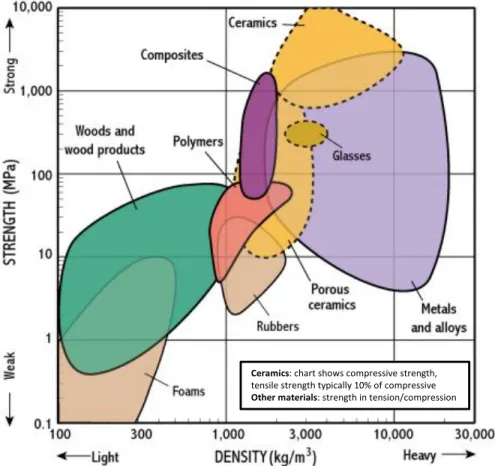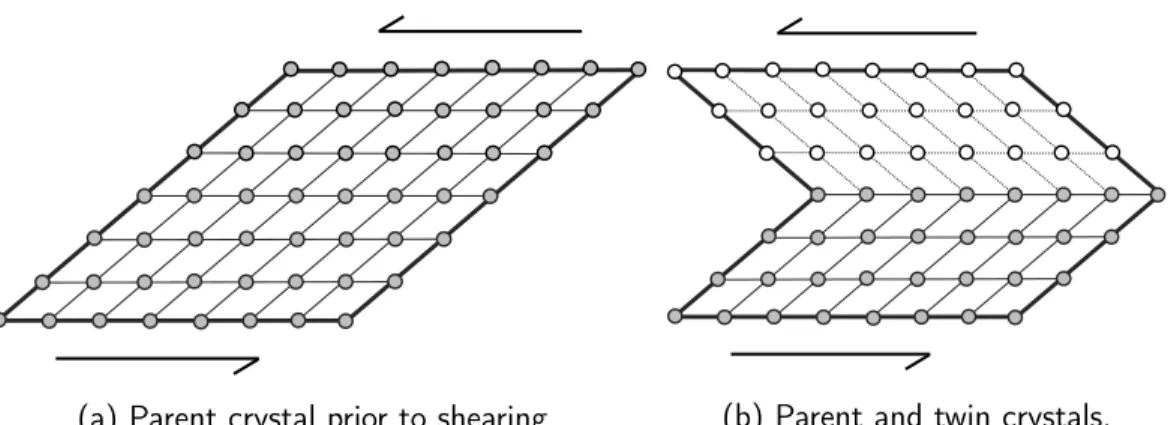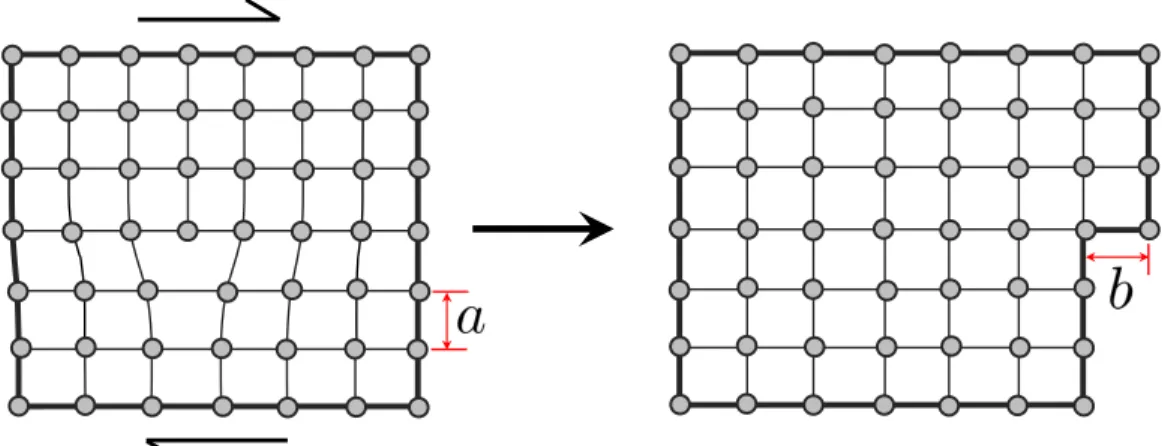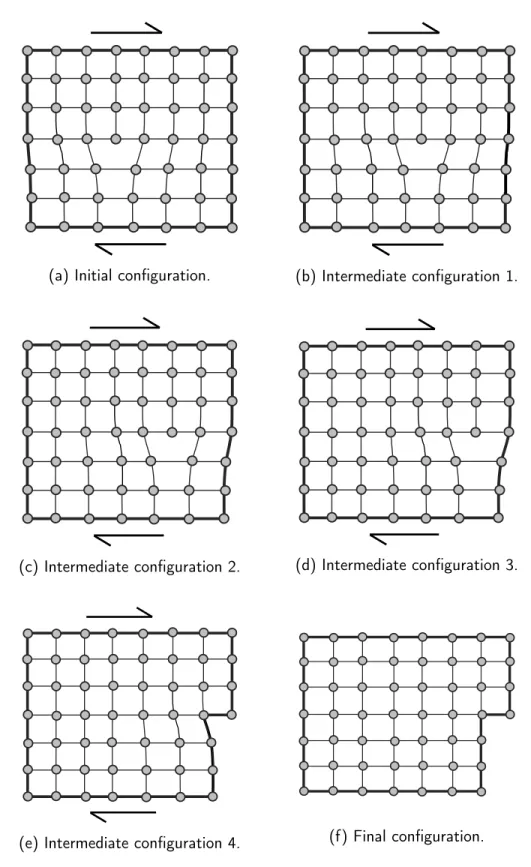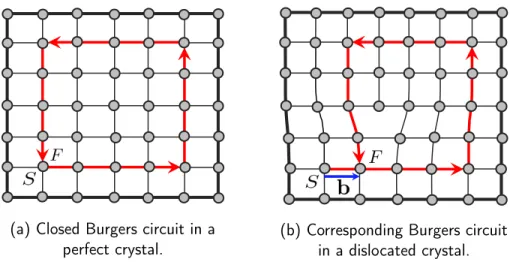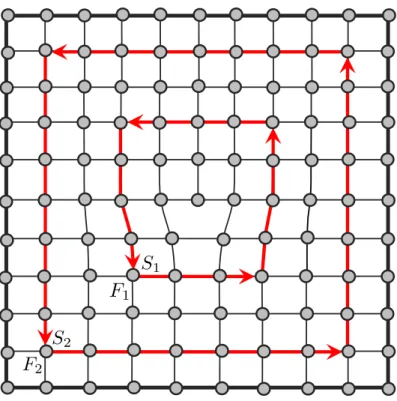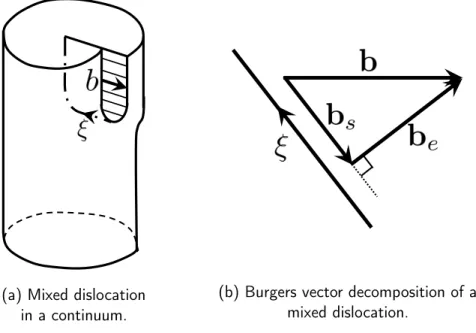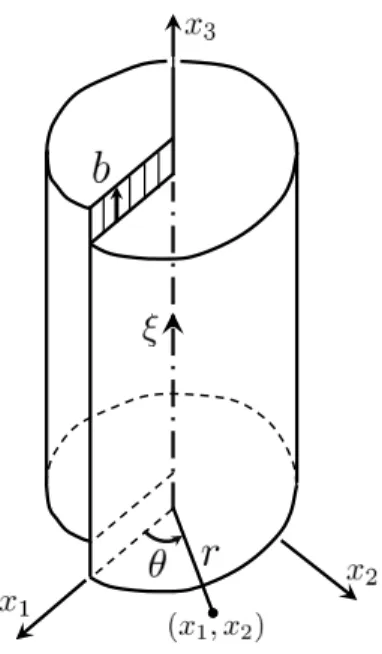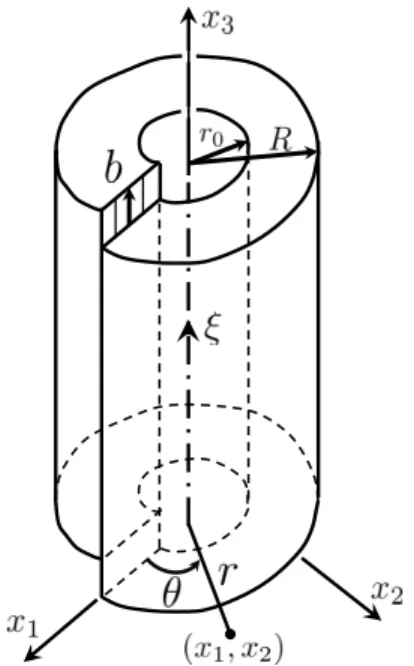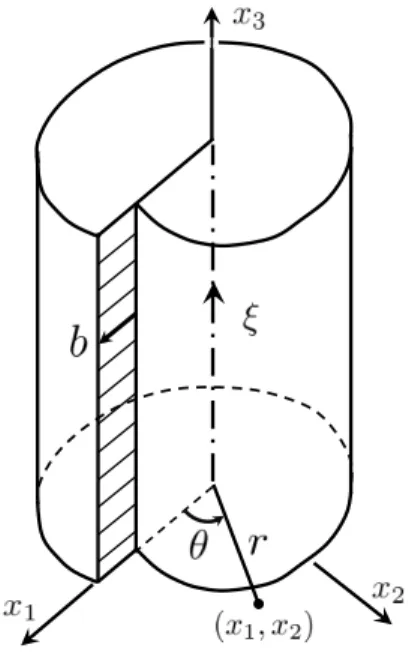Dynamics
Thesis by
Arnold Deffo
In Partial Fulfillment of the Requirements for the Degree of
Doctor of Philosophy
CALIFORNIA INSTITUTE OF TECHNOLOGY Pasadena, California
2019
Defended July 31, 2018
c 2019 Arnold Deffo
ORCID: 0000-0001-9077-8315
All rights reserved except where otherwise noted
In loving memory of Ma’a Angèle.
This work is the result of your sacrifices over the years.
ACKNOWLEDGEMENTS
It’s hard to believe that after five years of graduate studies, the most difficult part of writing this thesis is the Acknowledgements section. Indeed, so many people have contributed to my success over the years that despite my best efforts, I’m afraid I’ll forget to mention some of them here. To those people, I sincerely apologize and hope you know that I appreciate all you’ve done in helping shape the person I’m today.
With that said, I’d first and foremost like to thank my father Pa’a Fra and my brothers Bleriaud, Joël, Chanel, and Borel. Your optimism and confidence was a never-ending source of motivation. I particularly think of my father who, though he didn’t have a high school diploma, seemed to know the value of having a good education.
Second, I’d like to thank my advisor Prof. Michael Ortiz. You showed patience and understanding throughout this process and gave me the space and freedom to develop into the kind of researcher I’m today. I’m also grateful to Prof. Pilar Ariza for acting as a second advisor to me. I particularly appreciate your willingness to mentor me on some of the most basic tasks of my Ph.D. work.
Third, I’d like to thank Lydia Suarez for treating me like a mother treats a son. I don’t take for granted everything you’ve done for me and will remember it for years to come. I’m also grateful to the members of the Ortiz research group, past and present, for their willingness to lend a helping hand and provide feedback whenever needed. I’m especially thankful to Jonathan Chiang for providing assistance with some of the computer science components of my work.
Beyond the lab, I’d like to thank my many friends for providing relief from the stress I experienced throughout this process. As challenging as this journey has been, it would be more so without your support and laughters. I’m particularly indebted to the Sander family for providing me with a home away from home.
To Steve and Phyllis Brady: I’m thankful to you in so many ways that trying to list them here will be a futile experiment. Let me just say that your willingness to mentor that young student from Cameroon is something for which he will forever be grateful.
Going back further, this journey would not have been possible without papa Fokou Bernard who gave me the opportunity to pursue my studies in the U.S. Just like
me, I’m sure many young Bansoas appreciate the financial support you so willingly offer, which support provides life-long opportunities we would not have otherwise.
Finally, I’d like to thank Mr. and Mrs. Foster and Coco Stanback for providing funding for this thesis work through theStanback STEM Fellowship in Aerospace.
ABSTRACT
Despite the emergence of architected materials for various applications, metals still play a key role in engineering in general and aeronautics in particular. Turbine blades in jets engines for instance are made from single-crystal Nickel superalloys.
As a result, studying the failure mechanism of these crystalline materials would help understand the limits for their application. At the core of this mechanism are line defects calleddislocations. Indeed, the plastic deformation of metals is governed by the motion of dislocation ensembles inside the crystal. In this thesis, we propose a novel approach to dislocation dynamics through the method of monopoles. In this approach, we discretize the dislocation line as a collection of points (ormonopoles), each of which carries a Burgers "charge" and an element of line. The fundamental difference between our method and current methods for dislocation dynamics lies in the fact that the latter discretize the dislocation as a collection of line segments from which spans a need to keep track of the connectivity of the nodes. In our approach, we propose a "line-free" discretization where a linear connectivity or sequence between monopoles need not be defined. This attribute of the formulation offers significant computational advantages in terms of simplicity and efficiency.
Through verification examples, we show that our method is consistent with existing results for simple configurations. We then build on this success to investigate increasingly complex examples, with the ultimate goal of simulating the plastic deformation of a body-centered cubic grain in an elastic matrix.
PUBLISHED CONTENT AND CONTRIBUTIONS
[1] A. Deffo, M. P. Ariza, and M. Ortiz. “A Line-free Method of Monopoles for 3D Dislocation Dynamics”. In: ArXiv e-prints (June 2018). arXiv:1806.
04512 [physics.comp-ph].
A.D. participated in the development of the theory, the writing of the source code for numerical simulations, and the writing of the manuscript through figures and the derivation of various equations.
TABLE OF CONTENTS
Acknowledgements . . . iv
Abstract . . . vi
Published Content and Contributions . . . vii
Table of Contents . . . viii
List of Illustrations . . . x
Chapter I: Introduction . . . 1
1.1 Motivation . . . 1
1.2 Perfect and Real Crystals . . . 3
1.3 More on Dislocations . . . 7
1.4 Outline of the Thesis . . . 15
Chapter II: Continuum Theory of Dislocations . . . 17
2.1 Introduction . . . 17
2.2 Review of Classical Linear Elasticity Theory . . . 18
2.3 Straight Dislocations . . . 23
2.4 Curved Dislocations . . . 32
2.5 Forces on a Dislocation . . . 41
Chapter III: A Method of Monopoles for Dislocation Dynamics . . . 47
3.1 Introduction . . . 47
3.2 Previous Approaches to Dislocation Dynamics . . . 47
3.3 Introduction to the Method of Monopoles . . . 52
3.4 Dislocation Dynamics as a Transport Problem . . . 54
3.5 Mobility and Energetics . . . 59
3.6 Variational Formulation and Approximation . . . 67
3.7 Topological Transitions . . . 75
3.8 Summary . . . 79
Chapter IV: Verification Examples . . . 80
4.1 Introduction . . . 80
4.2 Infinite Straight Screw Dislocation . . . 80
4.3 Infinite Straight Edge Dislocation . . . 85
4.4 Circular Prismatic Dislocation Loop . . . 87
4.5 Summary . . . 94
Chapter V: Numerical Examples . . . 96
5.1 Introduction . . . 96
5.2 Activation of a Single Slip Plane . . . 96
5.3 Activation of a Single Slip System . . . 97
5.4 Activation of Multiple Slip Systems . . . 102
Chapter VI: Conclusion . . . 106
6.1 Summary . . . 106
6.2 Future Work . . . 107
Bibliography . . . 109
Appendix A: Interpolated Transport Maps . . . 120
A.1 Zeroth-order Max Ent Shape Functions . . . 120
A.2 Tests . . . 120
LIST OF ILLUSTRATIONS
Number Page
1.1 Difference in the path of a refracted wave in a metamaterial (with negative index of refraction) and in water (with positive index of refraction). . . 1 1.2 Classification of materials classes by their strength-to-weight ratio.
Image credit: http://www-materials.eng.cam.ac.uk/mpsite/
interactive_charts/strength-density/basic.html . . . . 2 1.3 Schematic of a perfect crystal with a unit cell highlighted. . . 4 1.4 Intrinsic point defects in a crystal. . . 4 1.5 Extrinsic point defects in a crystal. . . 5 1.6 Schematic of grain boundaries separating three single crystals of
different orientations. . . 6 1.7 (Deformation) twin boundary in a crystal. . . 7 1.8 Plastic deformation of a single crystal through shearing. . . 8 1.9 Sequence showing the role of dislocations in the plastic deformation
of crystals. . . 10 1.10 SF/RH Burgers circuit and Burgers vector in a crystal with a dis-
location. The positive sense of dislocation line is taken out of the page. . . 11 1.11 FS/RH Burgers circuit and Burgers vector in a crystal with a dis-
location. The positive sense of dislocation line is taken out of the page. . . 11 1.12 Equivalent Burgers circuits and corresponding (identical) Burgers
vectors in a dislocated crystal using the FS/RH convention. The positive sense of dislocation line is taken out of the page. . . 13 1.13 Conservation of Burgers vector at a dislocation node. . . 14 1.14 Illustration of edge and screw dislocations in a continuum. The
dislocation line is shown in the dash-dot pattern with direction ξ. 15 1.15 Illustration of a mixed dislocation in a continuum. The dislocation
line is shown in the dash-dot pattern with direction ξ. . . 16 2.1 Schematic illustrating the definition of the Burgers vector of a
dislocation in an elastic continuum. . . 17
2.2 Stress distribution on an infinitesimal volume element. . . 19 2.3 Body under displacement boundary conditions u¯i on its boundary
∂B1 and traction boundary conditions ¯ti on its boundary ∂B2. Note that if no traction or displacement is prescribed at a boundary, this is equivalent to having a traction of ¯ti = 0 at said boundary. . . . 20 2.4 Screw dislocation along the positive x3 axis in a cartesian coordinate
system. . . 24 2.5 Screw dislocation along the positive x3 axis in a hollow cylinder used
to compute the strain energy of the dislocation. . . 26 2.6 Edge dislocation along the positive x3 axis in a cartesian coordinate
system. . . 27 2.7 Edge dislocation along the positive x3 axis in a hollow cylinder used
to compute the strain energy of the dislocation. . . 29 2.8 Mixed dislocation in an infinite medium with its Burgers vector
inclined at an angle β to the dislocation line. . . 30 2.9 Displacement at the point x due to a point force at x0 inside an
anisotropic solid with boundary S. Here ∆S is any surface enclosing x0. . . 33 2.10 Schematic of a (closed) curved dislocation L in an infinite solid. S0
is an arbitrary surface bounded by the dislocation. . . 36 2.11 Schematic of the surface cap used for determination of the displace-
ment field of a curved dislocation. The cap consists of the cut faces S0− and S0+ and a tubular surface, Γ0, of radius r0 centered around the dislocation line. . . 36 2.12 Schematic of two dislocation loops within an infinite elastic continuum. 39 2.13 Schematic of a dislocation loop within an infinite elastic continuum. 41 2.14 An element dlof dislocation line moves a distance dx, thus increasing
the area swept by the dislocation by the amount δS0 =dx×dl. . 42 2.15 Principle of superposition used to define the image stress in a bounded
solid with a dislocation [71, 72]. σ corresponds to the stress in the finite dislocated solid as shown on the left. σ∞ corresponds to the stress in the infinite dislocated solid. This creates tractions t∞i at the boundary that would delimit the real finite solid. Finally, σI is the image stress in the finite solid free of dislocations. Note the traction boundary conditions used in this case. . . 44
2.16 Illustration of the core regularization proposed by Brown [74] in 1964.
The self-stress atxis computed as the average of those atx±m, wherem is the in-plane normal to the dislocation atx. . . 45 2.17 Illustration of the core regularization proposed by Hirth and Lothe
[26]. The self-stress at x is computed using Equation (2.69) but excluding a those points x0 that are a distance less than away from x. . . 45 3.1 Discretization of a curved dislocation into line segments (in red) in lattice-
based simulations. The integration points are taken as the middles of the segments. The outward arrows indicate the only possible directions of motion of the segments. . . 49 3.2 Discretization of a curved dislocation into line segments (in red) in nodal
simulations. . . 50 3.3 Circular prismatic loop. a) Regularized energy normalized by 8π(1−νµb2ρ2). b)
Regularized Peach-Koehler force per unit length normalized by 8π(1−ν)µb2 . Loop radius normalized by . . . 67 3.4 Convergence with respect to the number of monopoles for a circular
prismatic loop. a) Regularized elastic energy normalized by 8π(1−ν)µb2ρ2 . b) Regularized Peach-Koehler force normalized by 8π(1−ν)µb2 . Loop radius normalized by . . . 75 3.5 Schematic of junction formation. Two intersecting glissile dislocation lines
of Burgers vectors b1 and b2 zip up along a line of direction ξ on the intersection between their slip planes to form a sessile segment of Burgers vectorb3 =b1+b2. . . 76 4.1 Discretization of the screw dislocation segment in the method of monopoles. 81 4.2 Discretization of the screw dislocation segment in the method of monopoles. 85 4.3 Circular prismatic dislocation loop in an elastic continuum. . . 88 4.4 Discretization of the circular dislocation loop in the method of monopoles. 89 4.5 Evolution of a circular prismatic dislocation loop under its self-stress in
the method of monopoles. As expected, the dislocation shrinks under its self-stress while remaining circular. The grey lines indicate the trajectories of the monopoles. . . 90 4.6 Evolution of a circular prismatic dislocation loop under the action of an
applied stress σ33∞>0. The dislocation expands under the applied stress while remaining circular. The grey lines indicate the trajectories of the monopoles. . . 91
4.7 Accuracy of the algorithm in predicting the correct elements of line length.
Test case of the expanding circular prismatic loop. . . 93 4.8 Splitting of a monopole into two new ones. The Burgers vector of each
new monopole is the same as that of the parent monopole, while the element of line vector is half that of the parent monopole. . . 93 4.9 Evolution of a circular prismatic dislocation loop under the action of an
applied stressσ∞33>0 where we have implemented the splitting algorithm described in the text. The grey lines indicate the trajectories of the monopoles. . . 95 5.1 BCC grain in elastic matrix. Snapshots of single loop nucleating from a
randomly-located source and expanding under the action of an applied uniaxial stress until it reaches the impenetrable boundaries of the grain. 98 5.2 BCC grain in elastic matrix. Snapshots of multiple loops nucleating from
a common randomly-located source and expanding under the action of an applied uniaxial stress until they reach the impenetrable boundaries of the grain. . . 99 5.3 BCC grain in elastic matrix. Snapshots of single loops nucleating from
randomly-located sources on multiple parallel slip planes and expand- ing under the action of an applied uniaxial stress until they reach the impenetrable boundaries of the grain. . . 100 5.4 BCC grain in elastic matrix. Snapshots of multiple loops nucleating from
randomly-located sources on multiple parallel slip planes and expand- ing under the action of an applied uniaxial stress until they reach the impenetrable boundaries of the grain. . . 101 5.5 BCC grain in elastic matrix. Snapshots of two loops nucleating from two
different randomly-located sources on two slip systems and subsequently expanding under the action of an applied uniaxial stress until they reach the impenetrable boundaries of the grain. . . 103 5.6 BCC grain in elastic matrix. Snapshots of multiple loops nucleating from
randomly-located sources on multiple slip planes and expanding under the action of an applied uniaxial stress until they reach the impenetrable boundaries of the grain. . . 104 5.7 Computed plastic strain plotted against the monotonically increasing
remote stress for the dislocation ensemble displayed in Figure 5.6. . . . 105
C h a p t e r 1
INTRODUCTION
1.1 Motivation
Thanks to recent advances in materials science and engineering, researchers are now able to design materials tailored to specific applications. Consequently, it has become possible to meet design criteria that heretofore seemed unachievable.
A prime example is the use of metamaterials in electromagnetism. From the Greek meta- meaning "beyond", metamaterials are materials engineered to have electromagnetic properties not found in nature [1–3]. One such property is the ability to have a negative index of refraction over a range of frequencies [2–5].
To understand the implication of this property, consider an incident wave from air into water. Since the index of refraction of water is positive, the path of the refracted wave will be as shown in Figure 1.1a. However, if the wave travels from air into a metamaterial with negative index of refraction, the refracted wave will instead follow the trajectory shown in Figure 1.1b. An important application of this property is the ability to use metamaterials in the design of "superlenses", i.e.
lenses which, unlike conventional glass lenses, have resolution beyond the diffraction limit [6–8]. Beyond lenses, metamaterials also have applications in high-gain small antennas, electromagnetic absorbers, and ideal cloaking devices [2, 3, 7, 9–11].
(a) Path of a refracted wave in water.
(b) Path of a refracted wave in a metamaterial.
Figure 1.1: Difference in the path of a refracted wave in a metamaterial (with negative index of refraction) and in water (with positive index of refraction).
Another example of human-made materials for engineering purposes concerns the use of carbon fiber reinforced polymer (CFRP) in engineering structures where both strength and weight are important design parameters. Indeed, as shown in the Ashby plot of Figure 1.2, CFRP, or "composites" for short, have strength comparable to that of traditional metals while maintaining a lower density. For this reason, they have seen much use in the aerospace industry, where the airplane structure must be strong enough to withstand the loads experienced by the aircraft during flight while light enough that significant fuel savings can ensue. It is then no surprise that Boeing’s787 Dreamliner and Airbus’sA350XWB both have fuselage and wing structures made primarily of CFRP, making up 50% of the airplane’s weight [12–14].
Ceramics: chart shows compressive strength, tensile strength typically 10% of compressive Other materials: strength in tension/compression
Figure 1.2: Classification of materials classes by their strength-to-weight ratio.
Image credit: http://www-materials.eng.cam.ac.uk/mpsite/
interactive_charts/strength-density/basic.html
It is evident from the above two examples that architected materials have a promising future in science and engineering. However, despite the now widespread use of composites in the 787 Dreamliner, aluminum and titanium still make up 20
and 15% of the weight of the aircraft, respectively [12]. Furthermore, steel columns and beams are still prevalent structural elements in civil engineering. Finally, metals also have applications in medicine where titanium has become the material of choice in surgical implant procedures [15–17]. In other words, traditional materials and metals in particular are still ubiquitous in science and engineering and require just as much research. In this thesis, we deal with dislocations as line defects. Specifically, given the role of dislocations as agents of plastic deformation in metals, we propose a new approach to dislocation dynamics that offers significant computational advantages in terms of simplicity, robustness, and efficiency. However, before we lay out the details of this new approach, we first give a brief review of defects in crystals—Section 1.2. Section 1.3 expands on this topic further by specifically considering dislocations as line defects. Finally, the outline of the thesis is given in Section 1.4.
1.2 Perfect and Real Crystals
Metals and many important classes of nonmetallic solids arecrystalline, i.e. the con- stituents atoms are arranged in a pattern orunit cell that repeats itself periodically over three-dimensional space [18–20]. This is illustrated in Figure 1.3 for the case of a simple cubic structure. When a crystalline solid has a structure as described above, it is said to be a perfect or ideal crystal. However, the regular, strictly periodic structure of a crystal as described above is merely an idealized picture [21].
In nature, even under conditions of ideal thermodynamic equilibrium, real crystals deviate considerably from the aforementioned ideal model. All deviations from the ideal crystalline structure are called crystal defects [21, 22]. These defects, which strongly influence the properties of the crystal, can be classified into four main categories according to their dimensionality: point defects, line defects, surface defects, and volume defects [18, 19, 21, 22].
Point defects
Point defects are crystalline defects of dimension zero. Depending on the nature of the defect, they can be further classified as intrinsic or extrinsic [18].
Intrinsic point defects are characteristic of pure metals, i.e. metals comprising of only one element (Cu, Zn, Ni, etc.). Examples includevacancies andself-interstitials.
A vacancy is a crystal lattice defect where an atom is absent from a site where one should be expected. This is highlighted in Figure 1.4a. A self-interstitial on the other hand is a point defect where an atom is occupying a site that would
Figure 1.3: Schematic of a perfect crystal with a unit cell highlighted.
otherwise be free—see Figure 1.4b.
(a) Schematic of a real crystal with a vacancy.
(b) Schematic of a real crystal with a self-interstitial.
Figure 1.4: Intrinsic point defects in a crystal.
Extrinsic point defects on the other hand can only occur when a crystal contains foreign elements. Examples includesubstitutional impurity atoms and interstitial impurity atoms. A substitutional impurity atom is a lattice defect where a foreign (or "impurity") atom replaces (or "substitutes") a parent atom at a lattice site in the atomic structure [18]. An interstitial impurity atom is a point defect similar to a self-interstitial, but with the major distinction that the interstitial is a foreign atom. These concepts are illustrated in Figure 1.5a and 1.5b respectively.
It should be noted that the atomic lattice will typically be distorted in the vicinity
(a) Schematic of a real crystal with a substitutional impurity
atom.
(b) Schematic of a real crystal with an interstitial impurity atom.
Figure 1.5: Extrinsic point defects in a crystal.
of these defects. However, this is not illustrated in the simplified schematics of Figures 1.4 and 1.5.
Line defects
As suggested by the name, line defects are lattice defects of dimension one. In crystalline materials, these comprise of dislocations and disclinations. Unlike point defects which have short-range effects, dislocations and disclinations disturb the long-range order in a crystal [21]. Though recent research has evidenced the presence of disclinations in crystalline solids [23], these defects are commonly associated with liquid crystals [24, 25]. Indeed, disclinations—or "rotational dislocations" as they are sometimes called—do not appear as isolated defects in metals [19, 26], and we refer the interested reader to references [27–33] for further reading on the topic. As a result, we will only focus on dislocations as line defects in crystals.
However, we defer this discussion until Section 1.3.
Surface defects
These two-dimensional defects can be of many types, ranging from the mere presence of a crystal surface to stacking faults (irregularly packed atom layers), grain boundaries, and twin boundaries [18–22].
Since a perfect crystal is one in which atoms are arranged in a pattern that repeats itself periodically over space, one such crystal must necessarily be infinite. However, given that every crystal must be finite in size, there must be surfaces (i.e. 2-D
defects) that interrupt the infinite periodicity of the crystal, thus leading to surface defects [19, 21].
Moreover, crystalline solids usually consist of a large number of randomly oriented single crystals [18]. A grain boundary is the interface where two single crystals of different orientations join in such a manner that the material is continuous across the boundary [26]. Though Figure 1.6 illustrates this for straight grain boundaries, a grain boundary need not be straight. However, straight grain boundaries are more energetically favorable in thermal equilibrium since they minimize the boundary area and thus the boundary energy [26].
Figure 1.6: Schematic of grain boundaries separating three single crystals of different orientations.
Finally, a twin is a crystal with consistently mutually misoriented regions (twin components) whose atomic structure is related geometrically by some symmetry operation (e.g. reflection in a plane) [21]. In general, twins are of two classes:
growth twins and deformation twins. Growth twins arise during crystal growth and deformation twins arise through mechanical stress [22]. Specifically, deformation twinning is the process through which a region of the crystal undergoes homogeneous shear that produces the original crystal structure in a new orientation [18]. As a result, the twin component of the resulting crystal is a mirror image of the parent crystal through the twin or composition plane. This process is represented schematically in Figure 1.7.
(a) Parent crystal prior to shearing. (b) Parent and twin crystals.
Figure 1.7: (Deformation) twin boundary in a crystal.
Volume defects
Volume defects are three-dimensional defects that include voids (or clusters of vacancies),precipitates (or cluster of impurities),inclusions, and similar macroscopic formations [18, 21]. Though considered defects, some of these can be intentional as is the case in the development of high-strength alloys through the interaction between dislocations and precipitates.
1.3 More on Dislocations
Given that the subject matter of this thesis deals with dislocations, we return to these line defects to elaborate on the discussion started in Section 1.2.
Background on dislocations
Dislocations first appeared as an abstract mathematical concept in a 1907 paper by Volterra [33]. However, it would take researchers more than two decades to fully appreciate the role of these line defects in the plastic deformation of crystals.
To start, consider the crystal on the left in Figure 1.8 with a defect as shown.
Suppose we wish to "push" the defect outside the crystal through shear so as to obtain the configuration shown on the right.
In a perfect crystal, the sliding of one plane of atoms over an adjacent one would have to be a rigid cooperative motion of all atoms from one position of the perfect lattice to another [18]. Frenkel [34] first estimated the shear stress required for this process in 1926. Given the periodicity of the lattice, he assumed a periodic shear stress of form [18, 26, 35]
τ(x) = τtheorsin2πx
b , (1.1)
Figure 1.8: Plastic deformation of a single crystal through shearing.
where b is the magnitude of a simple lattice-translation vector (see Figure 1.8), x is the shear translation of the two rows away from the low-energy equilibrium position, andτtheor is the theoretical maximum shear stress of the crystal.
In the limit of small shear strainx/a, where a is the spacing between two adjacent rows of atoms (see Figure 1.8), Hooke’s law dictates that
τ(x) =µx
a, (1.2)
where µis the shear modulus of the crystal.
Comparing equations (1.1) and (1.2) in the small strain limit, one obtains µx
a =τtheor sin2πx
b ∼=τtheor
2πx b , from which it follows that
τtheor = µ 2π
b a or, since b ∼=a,
τtheor∼= µ
2π. (1.3)
Using more realistic expressions for the shear stress as a function of shear displace- ments, later estimates placed the theoretical value of the maximum shear stress between µ/30and µ/5at room temperature [26]. However, except for whiskers which are nearly free of defects, experimental observations in real, well-annealed crystals showed that the stress required for plastic deformation is at least several orders of magnitude smaller than the above estimates, between 10−9µ and 10−4µ [18, 20, 26, 35]. It wasn’t until 1934 with the independent works of Taylor, Polanyi,
and Orowan [36–39] that dislocations were found to be the source of plastic de- formation in crystalline materials. More specifically, rather than an entire row of atoms sliding rigidly over another, dislocations allow nearby atoms (and only these) to move one interatomic distance as the imperfection progressively advances inside the crystal (see Figure 1.9). As a result, much lower shear stresses are needed for plastic deformation, thus explaining the discrepancies between the theoretical and experimental values of the maximum shear stress in crystalline solids.
Today, dislocations are known to affect the mechanical, electrical, and even optical properties of crystals [40, 41]. Therefore, understanding the nature of these linear defects is of great importance in these various fields.
Burgers vector and Burgers circuit
As a one-dimensional crystal defect, a dislocation is uniquely characterized by a line direction and a "slip" vector called the Burgers vector [19, 20, 26]. This vector is the most important property of a dislocation and is constant along the dislocation line—except possibly in the highly strained regions near the center of the dislocation where the atomicity of the structure cannot be neglected—and remains so when the dislocation travels through the crystal [20, 35]. There are several equivalent definitions of the Burgers vector of a dislocation with some more useful than others depending on the context. For example, in Chapter 2, we’ll encounter a definition more appropriate for that context. In the meantime, the most useful definition is given in terms of what is commonly referred to as the Burgers circuit [18–20, 26, 35].
A Burgers circuit consists of any sequence of atom-to-atom steps and forms a closed loop when drawn in a perfect crystal. However, when the same Burgers circuit encloses a dislocation, it does not end at the starting atom and thus does not form a closed loop. The vector pointing from the starting atom to the ending atom, needed to complete the loop, is the Burgers vector of the dislocation. This is illustrated in Figure 1.10, where b represents the Burgers vector.
The convention used in the above characterization of the Burgers vector is sometimes referred to as the SF/RH Burgers circuit, meaning "Start to Finish; Right Hand"
convention. An equivalent definition can be stated starting with a closed loop in a dislocated crystal, and retracing the same circuit in a perfect crystal. In this case, the vector pointing from the ending atom to the starting atom needed to complete the loop is the Burgers vector of the dislocation—see Figure 1.11. Not
(a) Initial configuration. (b) Intermediate configuration 1.
(c) Intermediate configuration 2. (d) Intermediate configuration 3.
(e) Intermediate configuration 4. (f) Final configuration.
Figure 1.9: Sequence showing the role of dislocations in the plastic deformation of crystals.
(a) Closed Burgers circuit in a perfect crystal.
(b) Corresponding Burgers circuit in a dislocated crystal.
Figure 1.10: SF/RH Burgers circuit and Burgers vector in a crystal with a dislocation. The positive sense of dislocation line is taken out of the page.
surprisingly, this latter convention is known as the FS/RH characterization of the Burgers circuit. Nevertheless, as stated earlier, these two definitions are equivalent, as can be evidenced by the identical Burgers vectors in Figures 1.10b and 1.11b.
(a) Closed Burgers circuit in a dislocated crystal.
(b) Corresponding Burgers circuit in a perfect crystal.
Figure 1.11: FS/RH Burgers circuit and Burgers vector in a crystal with a dislocation. The positive sense of dislocation line is taken out of the page.
Equivalent Burgers Circuits
Using the FS/RH convention, consider the two Burgers circuits shown in the dislocated crystal of Figure 1.12a. Following the above example, we subsequently draw corresponding circuits in the perfect crystal. As can be seen from Figure 1.12b, both circuits result in the same Burgers vector, i.e. b1 =b2. When this is the case, the circuits are said to beequivalent. More precisely, two Burgers circuits
are said to be equivalent if one can be translated or deformed to coincide with the other without cutting through any "bad" material during this process [20, 26].
We can now prove the statement made earlier that the Burgers vector is constant along the dislocation line. In doing so, we consider a Burgers circuit around the dislocation. This circuit can be translated and deformed (through "good" material) along the dislocation line. By virtue of equivalent Burgers circuits, the resulting Burgers vectors should be identical to that of the original circuit. Thus, the Burgers vector is conserved along the dislocation.
Another important consequence of the equivalence of Burgers circuits is the fact that a dislocation cannot end inside a crystal. It must either form a closed loop, meet with other dislocations to form a node, or end at the surface of the crystal or at grain boundaries [18, 20, 26]. Indeed, consider a crystal with a single dislocation of nonzero Burgers vector and suppose that this dislocation ends inside the crystal.
Then, the original Burgers circuit can be translated and deformed so that it remains a closed loop while enclosing only "good" parts of the crystal, resulting in a zero Burger vector. By equivalence of Burgers circuits, the corresponding Burgers vectors should the identical, i.e. both zero in this case. But this contradicts the initial assumption that the dislocation had a nonzero Burgers vector.
We end our discussion of equivalent Burgers circuits by looking at the relationship between Burgers vectors for dislocations meeting at a node. To this end, we consider the dislocations of Figure 1.13 with their respective Burgers vectors and line directions as shown. We further assume that the the host crystal is otherwise free of other defects. Then, the Burgers circuits A and B are equivalents and we have that
b1 =b2+b3.
If the line direction ξ1 of the first dislocation is reversed, then the corresponding Burgers vector b1 is also reversed. This follows immediately from considering a Burgers circuit oriented in the opposite direction to that shown in Figure 1.13. In this case, equivalence of Burgers circuit gives
b1+b2+b3 =0
or, more generally, for n branching dislocations all oriented away from the node,
n
X
i=1
bi =0. (1.4)
S<latexit sha1_base64="h641UDLK5rUKDXT3Sif2pS/fizk=">AAAB6XicbVBNS8NAEJ34WetX1aOXxSJ4KokI6q3oxWOlxhbaUDbbTbt0swm7E6GE/gQvHlS8+o+8+W/ctjlo64OBx3szzMwLUykMuu63s7K6tr6xWdoqb+/s7u1XDg4fTZJpxn2WyES3Q2q4FIr7KFDydqo5jUPJW+Hoduq3nrg2IlEPOE55ENOBEpFgFK3UbPa8XqXq1twZyDLxClKFAo1e5avbT1gWc4VMUmM6nptikFONgkk+KXczw1PKRnTAO5YqGnMT5LNTJ+TUKn0SJdqWQjJTf0/kNDZmHIe2M6Y4NIveVPzP62QYXQW5UGmGXLH5oiiTBBMy/Zv0heYM5dgSyrSwtxI2pJoytOmUbQje4svLxD+vXde8+4tq/aZIowTHcAJn4MEl1OEOGuADgwE8wyu8OdJ5cd6dj3nrilPMHMEfOJ8/QTyNTw==</latexit><latexit sha1_base64="h641UDLK5rUKDXT3Sif2pS/fizk=">AAAB6XicbVBNS8NAEJ34WetX1aOXxSJ4KokI6q3oxWOlxhbaUDbbTbt0swm7E6GE/gQvHlS8+o+8+W/ctjlo64OBx3szzMwLUykMuu63s7K6tr6xWdoqb+/s7u1XDg4fTZJpxn2WyES3Q2q4FIr7KFDydqo5jUPJW+Hoduq3nrg2IlEPOE55ENOBEpFgFK3UbPa8XqXq1twZyDLxClKFAo1e5avbT1gWc4VMUmM6nptikFONgkk+KXczw1PKRnTAO5YqGnMT5LNTJ+TUKn0SJdqWQjJTf0/kNDZmHIe2M6Y4NIveVPzP62QYXQW5UGmGXLH5oiiTBBMy/Zv0heYM5dgSyrSwtxI2pJoytOmUbQje4svLxD+vXde8+4tq/aZIowTHcAJn4MEl1OEOGuADgwE8wyu8OdJ5cd6dj3nrilPMHMEfOJ8/QTyNTw==</latexit><latexit sha1_base64="h641UDLK5rUKDXT3Sif2pS/fizk=">AAAB6XicbVBNS8NAEJ34WetX1aOXxSJ4KokI6q3oxWOlxhbaUDbbTbt0swm7E6GE/gQvHlS8+o+8+W/ctjlo64OBx3szzMwLUykMuu63s7K6tr6xWdoqb+/s7u1XDg4fTZJpxn2WyES3Q2q4FIr7KFDydqo5jUPJW+Hoduq3nrg2IlEPOE55ENOBEpFgFK3UbPa8XqXq1twZyDLxClKFAo1e5avbT1gWc4VMUmM6nptikFONgkk+KXczw1PKRnTAO5YqGnMT5LNTJ+TUKn0SJdqWQjJTf0/kNDZmHIe2M6Y4NIveVPzP62QYXQW5UGmGXLH5oiiTBBMy/Zv0heYM5dgSyrSwtxI2pJoytOmUbQje4svLxD+vXde8+4tq/aZIowTHcAJn4MEl1OEOGuADgwE8wyu8OdJ5cd6dj3nrilPMHMEfOJ8/QTyNTw==</latexit><latexit sha1_base64="h641UDLK5rUKDXT3Sif2pS/fizk=">AAAB6XicbVBNS8NAEJ34WetX1aOXxSJ4KokI6q3oxWOlxhbaUDbbTbt0swm7E6GE/gQvHlS8+o+8+W/ctjlo64OBx3szzMwLUykMuu63s7K6tr6xWdoqb+/s7u1XDg4fTZJpxn2WyES3Q2q4FIr7KFDydqo5jUPJW+Hoduq3nrg2IlEPOE55ENOBEpFgFK3UbPa8XqXq1twZyDLxClKFAo1e5avbT1gWc4VMUmM6nptikFONgkk+KXczw1PKRnTAO5YqGnMT5LNTJ+TUKn0SJdqWQjJTf0/kNDZmHIe2M6Y4NIveVPzP62QYXQW5UGmGXLH5oiiTBBMy/Zv0heYM5dgSyrSwtxI2pJoytOmUbQje4svLxD+vXde8+4tq/aZIowTHcAJn4MEl1OEOGuADgwE8wyu8OdJ5cd6dj3nrilPMHMEfOJ8/QTyNTw==</latexit> 1
b
<latexit sha1_base64="Y6TaYBdpl21TyU8WoF8R5bBGJ5o=">AAAB8nicbVBNSwMxFHypX7V+VT16CRbBU9ktgnorevFYwbWF7lKyabYNzWaXJCuUpX/DiwcVr/4ab/4bs+0etHUgMMy8x5tMmAqujeN8o8ra+sbmVnW7trO7t39QPzx61EmmKPNoIhLVC4lmgkvmGW4E66WKkTgUrBtObgu/+8SU5ol8MNOUBTEZSR5xSoyVfD8mZhxGeTgbtAb1htN05sCrxC1JA0p0BvUvf5jQLGbSUEG07rtOaoKcKMOpYLOan2mWEjohI9a3VJKY6SCfZ57hM6sMcZQo+6TBc/X3Rk5iradxaCeLjHrZK8T/vH5moqsg5zLNDJN0cSjKBDYJLgrAQ64YNWJqCaGK26yYjoki1NiaarYEd/nLq8RrNa+b7v1Fo31TtlGFEziFc3DhEtpwBx3wgEIKz/AKbyhDL+gdfSxGK6jcOYY/QJ8/dFWRfw==</latexit><latexit sha1_base64="Y6TaYBdpl21TyU8WoF8R5bBGJ5o=">AAAB8nicbVBNSwMxFHypX7V+VT16CRbBU9ktgnorevFYwbWF7lKyabYNzWaXJCuUpX/DiwcVr/4ab/4bs+0etHUgMMy8x5tMmAqujeN8o8ra+sbmVnW7trO7t39QPzx61EmmKPNoIhLVC4lmgkvmGW4E66WKkTgUrBtObgu/+8SU5ol8MNOUBTEZSR5xSoyVfD8mZhxGeTgbtAb1htN05sCrxC1JA0p0BvUvf5jQLGbSUEG07rtOaoKcKMOpYLOan2mWEjohI9a3VJKY6SCfZ57hM6sMcZQo+6TBc/X3Rk5iradxaCeLjHrZK8T/vH5moqsg5zLNDJN0cSjKBDYJLgrAQ64YNWJqCaGK26yYjoki1NiaarYEd/nLq8RrNa+b7v1Fo31TtlGFEziFc3DhEtpwBx3wgEIKz/AKbyhDL+gdfSxGK6jcOYY/QJ8/dFWRfw==</latexit><latexit sha1_base64="Y6TaYBdpl21TyU8WoF8R5bBGJ5o=">AAAB8nicbVBNSwMxFHypX7V+VT16CRbBU9ktgnorevFYwbWF7lKyabYNzWaXJCuUpX/DiwcVr/4ab/4bs+0etHUgMMy8x5tMmAqujeN8o8ra+sbmVnW7trO7t39QPzx61EmmKPNoIhLVC4lmgkvmGW4E66WKkTgUrBtObgu/+8SU5ol8MNOUBTEZSR5xSoyVfD8mZhxGeTgbtAb1htN05sCrxC1JA0p0BvUvf5jQLGbSUEG07rtOaoKcKMOpYLOan2mWEjohI9a3VJKY6SCfZ57hM6sMcZQo+6TBc/X3Rk5iradxaCeLjHrZK8T/vH5moqsg5zLNDJN0cSjKBDYJLgrAQ64YNWJqCaGK26yYjoki1NiaarYEd/nLq8RrNa+b7v1Fo31TtlGFEziFc3DhEtpwBx3wgEIKz/AKbyhDL+gdfSxGK6jcOYY/QJ8/dFWRfw==</latexit> 2b
<latexit sha1_base64="f4OylRC4apiEp4Ls9HGku5V9CgQ=">AAAB8nicbVBNS8NAFHypX7V+VT16WSyCp5KIoN6KXjxWMLbQlLLZvrRLN5uwuxFK6N/w4kHFq7/Gm//GTZuDVgcWhpn3eLMTpoJr47pfTmVldW19o7pZ29re2d2r7x886CRTDH2WiER1Q6pRcIm+4UZgN1VI41BgJ5zcFH7nEZXmibw30xT7MR1JHnFGjZWCIKZmHEZ5OBt4g3rDbbpzkL/EK0kDSrQH9c9gmLAsRmmYoFr3PDc1/Zwqw5nAWS3INKaUTegIe5ZKGqPu5/PMM3JilSGJEmWfNGSu/tzIaaz1NA7tZJFRL3uF+J/Xy0x02c+5TDODki0ORZkgJiFFAWTIFTIjppZQprjNStiYKsqMralmS/CWv/yX+GfNq6Z3d95oXZdtVOEIjuEUPLiAFtxCG3xgkMITvMCrkznPzpvzvhitOOXOIfyC8/ENctKRfg==</latexit><latexit sha1_base64="f4OylRC4apiEp4Ls9HGku5V9CgQ=">AAAB8nicbVBNS8NAFHypX7V+VT16WSyCp5KIoN6KXjxWMLbQlLLZvrRLN5uwuxFK6N/w4kHFq7/Gm//GTZuDVgcWhpn3eLMTpoJr47pfTmVldW19o7pZ29re2d2r7x886CRTDH2WiER1Q6pRcIm+4UZgN1VI41BgJ5zcFH7nEZXmibw30xT7MR1JHnFGjZWCIKZmHEZ5OBt4g3rDbbpzkL/EK0kDSrQH9c9gmLAsRmmYoFr3PDc1/Zwqw5nAWS3INKaUTegIe5ZKGqPu5/PMM3JilSGJEmWfNGSu/tzIaaz1NA7tZJFRL3uF+J/Xy0x02c+5TDODki0ORZkgJiFFAWTIFTIjppZQprjNStiYKsqMralmS/CWv/yX+GfNq6Z3d95oXZdtVOEIjuEUPLiAFtxCG3xgkMITvMCrkznPzpvzvhitOOXOIfyC8/ENctKRfg==</latexit><latexit sha1_base64="f4OylRC4apiEp4Ls9HGku5V9CgQ=">AAAB8nicbVBNS8NAFHypX7V+VT16WSyCp5KIoN6KXjxWMLbQlLLZvrRLN5uwuxFK6N/w4kHFq7/Gm//GTZuDVgcWhpn3eLMTpoJr47pfTmVldW19o7pZ29re2d2r7x886CRTDH2WiER1Q6pRcIm+4UZgN1VI41BgJ5zcFH7nEZXmibw30xT7MR1JHnFGjZWCIKZmHEZ5OBt4g3rDbbpzkL/EK0kDSrQH9c9gmLAsRmmYoFr3PDc1/Zwqw5nAWS3INKaUTegIe5ZKGqPu5/PMM3JilSGJEmWfNGSu/tzIaaz1NA7tZJFRL3uF+J/Xy0x02c+5TDODki0ORZkgJiFFAWTIFTIjppZQprjNStiYKsqMralmS/CWv/yX+GfNq6Z3d95oXZdtVOEIjuEUPLiAFtxCG3xgkMITvMCrkznPzpvzvhitOOXOIfyC8/ENctKRfg==</latexit> 1S<latexit sha1_base64="116j+YFAkXU6zgcKR5hkfJSSjLc=">AAAB6XicbVBNS8NAEJ3Ur1q/qh69LBbBU0mKoN6KXjxWamyhDWWz3bRLN5uwOxFK6U/w4kHFq//Im//GbZuDtj4YeLw3w8y8MJXCoOt+O4W19Y3NreJ2aWd3b/+gfHj0aJJMM+6zRCa6HVLDpVDcR4GSt1PNaRxK3gpHtzO/9cS1EYl6wHHKg5gOlIgEo2ilZrNX65UrbtWdg6wSLycVyNHolb+6/YRlMVfIJDWm47kpBhOqUTDJp6VuZnhK2YgOeMdSRWNugsn81Ck5s0qfRIm2pZDM1d8TExobM45D2xlTHJplbyb+53UyjK6CiVBphlyxxaIokwQTMvub9IXmDOXYEsq0sLcSNqSaMrTplGwI3vLLq8SvVa+r3v1FpX6Tp1GEEziFc/DgEupwBw3wgcEAnuEV3hzpvDjvzseiteDkM8fwB87nD0K/jVA=</latexit><latexit sha1_base64="116j+YFAkXU6zgcKR5hkfJSSjLc=">AAAB6XicbVBNS8NAEJ3Ur1q/qh69LBbBU0mKoN6KXjxWamyhDWWz3bRLN5uwOxFK6U/w4kHFq//Im//GbZuDtj4YeLw3w8y8MJXCoOt+O4W19Y3NreJ2aWd3b/+gfHj0aJJMM+6zRCa6HVLDpVDcR4GSt1PNaRxK3gpHtzO/9cS1EYl6wHHKg5gOlIgEo2ilZrNX65UrbtWdg6wSLycVyNHolb+6/YRlMVfIJDWm47kpBhOqUTDJp6VuZnhK2YgOeMdSRWNugsn81Ck5s0qfRIm2pZDM1d8TExobM45D2xlTHJplbyb+53UyjK6CiVBphlyxxaIokwQTMvub9IXmDOXYEsq0sLcSNqSaMrTplGwI3vLLq8SvVa+r3v1FpX6Tp1GEEziFc/DgEupwBw3wgcEAnuEV3hzpvDjvzseiteDkM8fwB87nD0K/jVA=</latexit><latexit sha1_base64="116j+YFAkXU6zgcKR5hkfJSSjLc=">AAAB6XicbVBNS8NAEJ3Ur1q/qh69LBbBU0mKoN6KXjxWamyhDWWz3bRLN5uwOxFK6U/w4kHFq//Im//GbZuDtj4YeLw3w8y8MJXCoOt+O4W19Y3NreJ2aWd3b/+gfHj0aJJMM+6zRCa6HVLDpVDcR4GSt1PNaRxK3gpHtzO/9cS1EYl6wHHKg5gOlIgEo2ilZrNX65UrbtWdg6wSLycVyNHolb+6/YRlMVfIJDWm47kpBhOqUTDJp6VuZnhK2YgOeMdSRWNugsn81Ck5s0qfRIm2pZDM1d8TExobM45D2xlTHJplbyb+53UyjK6CiVBphlyxxaIokwQTMvub9IXmDOXYEsq0sLcSNqSaMrTplGwI3vLLq8SvVa+r3v1FpX6Tp1GEEziFc/DgEupwBw3wgcEAnuEV3hzpvDjvzseiteDkM8fwB87nD0K/jVA=</latexit> 2
F2
<latexit sha1_base64="b/OeDBoKVbipunJLePjkC0CHL24=">AAAB6XicbVBNS8NAEJ3Ur1q/qh69LBbBU0mKoN6KgnisaGyhDWWznbZLN5uwuxFK6E/w4kHFq//Im//GbZuDtj4YeLw3w8y8MBFcG9f9dgorq2vrG8XN0tb2zu5eef/gUcepYuizWMSqFVKNgkv0DTcCW4lCGoUCm+Hoeuo3n1BpHssHM04wiOhA8j5n1Fjp/qZb65YrbtWdgSwTLycVyNHolr86vZilEUrDBNW67bmJCTKqDGcCJ6VOqjGhbEQH2LZU0gh1kM1OnZATq/RIP1a2pCEz9fdERiOtx1FoOyNqhnrRm4r/ee3U9C+CjMskNSjZfFE/FcTEZPo36XGFzIixJZQpbm8lbEgVZcamU7IheIsvLxO/Vr2sendnlfpVnkYRjuAYTsGDc6jDLTTABwYDeIZXeHOE8+K8Ox/z1oKTzxzCHzifPy7+jUM=</latexit><latexit sha1_base64="b/OeDBoKVbipunJLePjkC0CHL24=">AAAB6XicbVBNS8NAEJ3Ur1q/qh69LBbBU0mKoN6KgnisaGyhDWWznbZLN5uwuxFK6E/w4kHFq//Im//GbZuDtj4YeLw3w8y8MBFcG9f9dgorq2vrG8XN0tb2zu5eef/gUcepYuizWMSqFVKNgkv0DTcCW4lCGoUCm+Hoeuo3n1BpHssHM04wiOhA8j5n1Fjp/qZb65YrbtWdgSwTLycVyNHolr86vZilEUrDBNW67bmJCTKqDGcCJ6VOqjGhbEQH2LZU0gh1kM1OnZATq/RIP1a2pCEz9fdERiOtx1FoOyNqhnrRm4r/ee3U9C+CjMskNSjZfFE/FcTEZPo36XGFzIixJZQpbm8lbEgVZcamU7IheIsvLxO/Vr2sendnlfpVnkYRjuAYTsGDc6jDLTTABwYDeIZXeHOE8+K8Ox/z1oKTzxzCHzifPy7+jUM=</latexit><latexit sha1_base64="b/OeDBoKVbipunJLePjkC0CHL24=">AAAB6XicbVBNS8NAEJ3Ur1q/qh69LBbBU0mKoN6KgnisaGyhDWWznbZLN5uwuxFK6E/w4kHFq//Im//GbZuDtj4YeLw3w8y8MBFcG9f9dgorq2vrG8XN0tb2zu5eef/gUcepYuizWMSqFVKNgkv0DTcCW4lCGoUCm+Hoeuo3n1BpHssHM04wiOhA8j5n1Fjp/qZb65YrbtWdgSwTLycVyNHolr86vZilEUrDBNW67bmJCTKqDGcCJ6VOqjGhbEQH2LZU0gh1kM1OnZATq/RIP1a2pCEz9fdERiOtx1FoOyNqhnrRm4r/ee3U9C+CjMskNSjZfFE/FcTEZPo36XGFzIixJZQpbm8lbEgVZcamU7IheIsvLxO/Vr2sendnlfpVnkYRjuAYTsGDc6jDLTTABwYDeIZXeHOE8+K8Ox/z1oKTzxzCHzifPy7+jUM=</latexit>
F1
<latexit sha1_base64="2zUXUs6uSlG92cIhuLjD1s4GgMM=">AAAB6XicbVBNS8NAEJ3Ur1q/qh69LBbBU0lEUG9FQTxWNLbQhrLZTtqlm03Y3Qgl9Cd48aDi1X/kzX/jts1Bqw8GHu/NMDMvTAXXxnW/nNLS8srqWnm9srG5tb1T3d170EmmGPosEYlqh1Sj4BJ9w43AdqqQxqHAVji6mvqtR1SaJ/LejFMMYjqQPOKMGivdXfe8XrXm1t0ZyF/iFaQGBZq96me3n7AsRmmYoFp3PDc1QU6V4UzgpNLNNKaUjegAO5ZKGqMO8tmpE3JklT6JEmVLGjJTf07kNNZ6HIe2M6ZmqBe9qfif18lMdB7kXKaZQcnmi6JMEJOQ6d+kzxUyI8aWUKa4vZWwIVWUGZtOxYbgLb78l/gn9Yu6d3taa1wWaZThAA7hGDw4gwbcQBN8YDCAJ3iBV0c4z86b8z5vLTnFzD78gvPxDS17jUI=</latexit><latexit sha1_base64="2zUXUs6uSlG92cIhuLjD1s4GgMM=">AAAB6XicbVBNS8NAEJ3Ur1q/qh69LBbBU0lEUG9FQTxWNLbQhrLZTtqlm03Y3Qgl9Cd48aDi1X/kzX/jts1Bqw8GHu/NMDMvTAXXxnW/nNLS8srqWnm9srG5tb1T3d170EmmGPosEYlqh1Sj4BJ9w43AdqqQxqHAVji6mvqtR1SaJ/LejFMMYjqQPOKMGivdXfe8XrXm1t0ZyF/iFaQGBZq96me3n7AsRmmYoFp3PDc1QU6V4UzgpNLNNKaUjegAO5ZKGqMO8tmpE3JklT6JEmVLGjJTf07kNNZ6HIe2M6ZmqBe9qfif18lMdB7kXKaZQcnmi6JMEJOQ6d+kzxUyI8aWUKa4vZWwIVWUGZtOxYbgLb78l/gn9Yu6d3taa1wWaZThAA7hGDw4gwbcQBN8YDCAJ3iBV0c4z86b8z5vLTnFzD78gvPxDS17jUI=</latexit><latexit sha1_base64="2zUXUs6uSlG92cIhuLjD1s4GgMM=">AAAB6XicbVBNS8NAEJ3Ur1q/qh69LBbBU0lEUG9FQTxWNLbQhrLZTtqlm03Y3Qgl9Cd48aDi1X/kzX/jts1Bqw8GHu/NMDMvTAXXxnW/nNLS8srqWnm9srG5tb1T3d170EmmGPosEYlqh1Sj4BJ9w43AdqqQxqHAVji6mvqtR1SaJ/LejFMMYjqQPOKMGivdXfe8XrXm1t0ZyF/iFaQGBZq96me3n7AsRmmYoFp3PDc1QU6V4UzgpNLNNKaUjegAO5ZKGqMO8tmpE3JklT6JEmVLGjJTf07kNNZ6HIe2M6ZmqBe9qfif18lMdB7kXKaZQcnmi6JMEJOQ6d+kzxUyI8aWUKa4vZWwIVWUGZtOxYbgLb78l/gn9Yu6d3taa1wWaZThAA7hGDw4gwbcQBN8YDCAJ3iBV0c4z86b8z5vLTnFzD78gvPxDS17jUI=</latexit>
S<latexit sha1_base64="h641UDLK5rUKDXT3Sif2pS/fizk=">AAAB6XicbVBNS8NAEJ34WetX1aOXxSJ4KokI6q3oxWOlxhbaUDbbTbt0swm7E6GE/gQvHlS8+o+8+W/ctjlo64OBx3szzMwLUykMuu63s7K6tr6xWdoqb+/s7u1XDg4fTZJpxn2WyES3Q2q4FIr7KFDydqo5jUPJW+Hoduq3nrg2IlEPOE55ENOBEpFgFK3UbPa8XqXq1twZyDLxClKFAo1e5avbT1gWc4VMUmM6nptikFONgkk+KXczw1PKRnTAO5YqGnMT5LNTJ+TUKn0SJdqWQjJTf0/kNDZmHIe2M6Y4NIveVPzP62QYXQW5UGmGXLH5oiiTBBMy/Zv0heYM5dgSyrSwtxI2pJoytOmUbQje4svLxD+vXde8+4tq/aZIowTHcAJn4MEl1OEOGuADgwE8wyu8OdJ5cd6dj3nrilPMHMEfOJ8/QTyNTw==</latexit><latexit sha1_base64="h641UDLK5rUKDXT3Sif2pS/fizk=">AAAB6XicbVBNS8NAEJ34WetX1aOXxSJ4KokI6q3oxWOlxhbaUDbbTbt0swm7E6GE/gQvHlS8+o+8+W/ctjlo64OBx3szzMwLUykMuu63s7K6tr6xWdoqb+/s7u1XDg4fTZJpxn2WyES3Q2q4FIr7KFDydqo5jUPJW+Hoduq3nrg2IlEPOE55ENOBEpFgFK3UbPa8XqXq1twZyDLxClKFAo1e5avbT1gWc4VMUmM6nptikFONgkk+KXczw1PKRnTAO5YqGnMT5LNTJ+TUKn0SJdqWQjJTf0/kNDZmHIe2M6Y4NIveVPzP62QYXQW5UGmGXLH5oiiTBBMy/Zv0heYM5dgSyrSwtxI2pJoytOmUbQje4svLxD+vXde8+4tq/aZIowTHcAJn4MEl1OEOGuADgwE8wyu8OdJ5cd6dj3nrilPMHMEfOJ8/QTyNTw==</latexit><latexit sha1_base64="h641UDLK5rUKDXT3Sif2pS/fizk=">AAAB6XicbVBNS8NAEJ34WetX1aOXxSJ4KokI6q3oxWOlxhbaUDbbTbt0swm7E6GE/gQvHlS8+o+8+W/ctjlo64OBx3szzMwLUykMuu63s7K6tr6xWdoqb+/s7u1XDg4fTZJpxn2WyES3Q2q4FIr7KFDydqo5jUPJW+Hoduq3nrg2IlEPOE55ENOBEpFgFK3UbPa8XqXq1twZyDLxClKFAo1e5avbT1gWc4VMUmM6nptikFONgkk+KXczw1PKRnTAO5YqGnMT5LNTJ+TUKn0SJdqWQjJTf0/kNDZmHIe2M6Y4NIveVPzP62QYXQW5UGmGXLH5oiiTBBMy/Zv0heYM5dgSyrSwtxI2pJoytOmUbQje4svLxD+vXde8+4tq/aZIowTHcAJn4MEl1OEOGuADgwE8wyu8OdJ5cd6dj3nrilPMHMEfOJ8/QTyNTw==</latexit><latexit sha1_base64="h641UDLK5rUKDXT3Sif2pS/fizk=">AAAB6XicbVBNS8NAEJ34WetX1aOXxSJ4KokI6q3oxWOlxhbaUDbbTbt0swm7E6GE/gQvHlS8+o+8+W/ctjlo64OBx3szzMwLUykMuu63s7K6tr6xWdoqb+/s7u1XDg4fTZJpxn2WyES3Q2q4FIr7KFDydqo5jUPJW+Hoduq3nrg2IlEPOE55ENOBEpFgFK3UbPa8XqXq1twZyDLxClKFAo1e5avbT1gWc4VMUmM6nptikFONgkk+KXczw1PKRnTAO5YqGnMT5LNTJ+TUKn0SJdqWQjJTf0/kNDZmHIe2M6Y4NIveVPzP62QYXQW5UGmGXLH5oiiTBBMy/Zv0heYM5dgSyrSwtxI2pJoytOmUbQje4svLxD+vXde8+4tq/aZIowTHcAJn4MEl1OEOGuADgwE8wyu8OdJ5cd6dj3nrilPMHMEfOJ8/QTyNTw==</latexit> 1
S2
<latexit sha1_base64="116j+YFAkXU6zgcKR5hkfJSSjLc=">AAAB6XicbVBNS8NAEJ3Ur1q/qh69LBbBU0mKoN6KXjxWamyhDWWz3bRLN5uwOxFK6U/w4kHFq//Im//GbZuDtj4YeLw3w8y8MJXCoOt+O4W19Y3NreJ2aWd3b/+gfHj0aJJMM+6zRCa6HVLDpVDcR4GSt1PNaRxK3gpHtzO/9cS1EYl6wHHKg5gOlIgEo2ilZrNX65UrbtWdg6wSLycVyNHolb+6/YRlMVfIJDWm47kpBhOqUTDJp6VuZnhK2YgOeMdSRWNugsn81Ck5s0qfRIm2pZDM1d8TExobM45D2xlTHJplbyb+53UyjK6CiVBphlyxxaIokwQTMvub9IXmDOXYEsq0sLcSNqSaMrTplGwI3vLLq8SvVa+r3v1FpX6Tp1GEEziFc/DgEupwBw3wgcEAnuEV3hzpvDjvzseiteDkM8fwB87nD0K/jVA=</latexit><latexit sha1_base64="116j+YFAkXU6zgcKR5hkfJSSjLc=">AAAB6XicbVBNS8NAEJ3Ur1q/qh69LBbBU0mKoN6KXjxWamyhDWWz3bRLN5uwOxFK6U/w4kHFq//Im//GbZuDtj4YeLw3w8y8MJXCoOt+O4W19Y3NreJ2aWd3b/+gfHj0aJJMM+6zRCa6HVLDpVDcR4GSt1PNaRxK3gpHtzO/9cS1EYl6wHHKg5gOlIgEo2ilZrNX65UrbtWdg6wSLycVyNHolb+6/YRlMVfIJDWm47kpBhOqUTDJp6VuZnhK2YgOeMdSRWNugsn81Ck5s0qfRIm2pZDM1d8TExobM45D2xlTHJplbyb+53UyjK6CiVBphlyxxaIokwQTMvub9IXmDOXYEsq0sLcSNqSaMrTplGwI3vLLq8SvVa+r3v1FpX6Tp1GEEziFc/DgEupwBw3wgcEAnuEV3hzpvDjvzseiteDkM8fwB87nD0K/jVA=</latexit><latexit sha1_base64="116j+YFAkXU6zgcKR5hkfJSSjLc=">AAAB6XicbVBNS8NAEJ3Ur1q/qh69LBbBU0mKoN6KXjxWamyhDWWz3bRLN5uwOxFK6U/w4kHFq//Im//GbZuDtj4YeLw3w8y8MJXCoOt+O4W19Y3NreJ2aWd3b/+gfHj0aJJMM+6zRCa6HVLDpVDcR4GSt1PNaRxK3gpHtzO/9cS1EYl6wHHKg5gOlIgEo2ilZrNX65UrbtWdg6wSLycVyNHolb+6/YRlMVfIJDWm47kpBhOqUTDJp6VuZnhK2YgOeMdSRWNugsn81Ck5s0qfRIm2pZDM1d8TExobM45D2xlTHJplbyb+53UyjK6CiVBphlyxxaIokwQTMvub9IXmDOXYEsq0sLcSNqSaMrTplGwI3vLLq8SvVa+r3v1FpX6Tp1GEEziFc/DgEupwBw3wgcEAnuEV3hzpvDjvzseiteDkM8fwB87nD0K/jVA=</latexit>
F2
<latexit sha1_base64="b/OeDBoKVbipunJLePjkC0CHL24=">AAAB6XicbVBNS8NAEJ3Ur1q/qh69LBbBU0mKoN6KgnisaGyhDWWznbZLN5uwuxFK6E/w4kHFq//Im//GbZuDtj4YeLw3w8y8MBFcG9f9dgorq2vrG8XN0tb2zu5eef/gUcepYuizWMSqFVKNgkv0DTcCW4lCGoUCm+Hoeuo3n1BpHssHM04wiOhA8j5n1Fjp/qZb65YrbtWdgSwTLycVyNHolr86vZilEUrDBNW67bmJCTKqDGcCJ6VOqjGhbEQH2LZU0gh1kM1OnZATq/RIP1a2pCEz9fdERiOtx1FoOyNqhnrRm4r/ee3U9C+CjMskNSjZfFE/FcTEZPo36XGFzIixJZQpbm8lbEgVZcamU7IheIsvLxO/Vr2sendnlfpVnkYRjuAYTsGDc6jDLTTABwYDeIZXeHOE8+K8Ox/z1oKTzxzCHzifPy7+jUM=</latexit><latexit sha1_base64="b/OeDBoKVbipunJLePjkC0CHL24=">AAAB6XicbVBNS8NAEJ3Ur1q/qh69LBbBU0mKoN6KgnisaGyhDWWznbZLN5uwuxFK6E/w4kHFq//Im//GbZuDtj4YeLw3w8y8MBFcG9f9dgorq2vrG8XN0tb2zu5eef/gUcepYuizWMSqFVKNgkv0DTcCW4lCGoUCm+Hoeuo3n1BpHssHM04wiOhA8j5n1Fjp/qZb65YrbtWdgSwTLycVyNHolr86vZilEUrDBNW67bmJCTKqDGcCJ6VOqjGhbEQH2LZU0gh1kM1OnZATq/RIP1a2pCEz9fdERiOtx1FoOyNqhnrRm4r/ee3U9C+CjMskNSjZfFE/FcTEZPo36XGFzIixJZQpbm8lbEgVZcamU7IheIsvLxO/Vr2sendnlfpVnkYRjuAYTsGDc6jDLTTABwYDeIZXeHOE8+K8Ox/z1oKTzxzCHzifPy7+jUM=</latexit><latexit sha1_base64="b/OeDBoKVbipunJLePjkC0CHL24=">AAAB6XicbVBNS8NAEJ3Ur1q/qh69LBbBU0mKoN6KgnisaGyhDWWznbZLN5uwuxFK6E/w4kHFq//Im//GbZuDtj4YeLw3w8y8MBFcG9f9dgorq2vrG8XN0tb2zu5eef/gUcepYuizWMSqFVKNgkv0DTcCW4lCGoUCm+Hoeuo3n1BpHssHM04wiOhA8j5n1Fjp/qZb65YrbtWdgSwTLycVyNHolr86vZilEUrDBNW67bmJCTKqDGcCJ6VOqjGhbEQH2LZU0gh1kM1OnZATq/RIP1a2pCEz9fdERiOtx1FoOyNqhnrRm4r/ee3U9C+CjMskNSjZfFE/FcTEZPo36XGFzIixJZQpbm8lbEgVZcamU7IheIsvLxO/Vr2sendnlfpVnkYRjuAYTsGDc6jDLTTABwYDeIZXeHOE8+K8Ox/z1oKTzxzCHzifPy7+jUM=</latexit>
F<latexit sha1_base64="2zUXUs6uSlG92cIhuLjD1s4GgMM=">AAAB6XicbVBNS8NAEJ3Ur1q/qh69LBbBU0lEUG9FQTxWNLbQhrLZTtqlm03Y3Qgl9Cd48aDi1X/kzX/jts1Bqw8GHu/NMDMvTAXXxnW/nNLS8srqWnm9srG5tb1T3d170EmmGPosEYlqh1Sj4BJ9w43AdqqQxqHAVji6mvqtR1SaJ/LejFMMYjqQPOKMGivdXfe8XrXm1t0ZyF/iFaQGBZq96me3n7AsRmmYoFp3PDc1QU6V4UzgpNLNNKaUjegAO5ZKGqMO8tmpE3JklT6JEmVLGjJTf07kNNZ6HIe2M6ZmqBe9qfif18lMdB7kXKaZQcnmi6JMEJOQ6d+kzxUyI8aWUKa4vZWwIVWUGZtOxYbgLb78l/gn9Yu6d3taa1wWaZThAA7hGDw4gwbcQBN8YDCAJ3iBV0c4z86b8z5vLTnFzD78gvPxDS17jUI=</latexit><latexit sha1_base64="2zUXUs6uSlG92cIhuLjD1s4GgMM=">AAAB6XicbVBNS8NAEJ3Ur1q/qh69LBbBU0lEUG9FQTxWNLbQhrLZTtqlm03Y3Qgl9Cd48aDi1X/kzX/jts1Bqw8GHu/NMDMvTAXXxnW/nNLS8srqWnm9srG5tb1T3d170EmmGPosEYlqh1Sj4BJ9w43AdqqQxqHAVji6mvqtR1SaJ/LejFMMYjqQPOKMGivdXfe8XrXm1t0ZyF/iFaQGBZq96me3n7AsRmmYoFp3PDc1QU6V4UzgpNLNNKaUjegAO5ZKGqMO8tmpE3JklT6JEmVLGjJTf07kNNZ6HIe2M6ZmqBe9qfif18lMdB7kXKaZQcnmi6JMEJOQ6d+kzxUyI8aWUKa4vZWwIVWUGZtOxYbgLb78l/gn9Yu6d3taa1wWaZThAA7hGDw4gwbcQBN8YDCAJ3iBV0c4z86b8z5vLTnFzD78gvPxDS17jUI=</latexit><latexit sha1_base64="2zUXUs6uSlG92cIhuLjD1s4GgMM=">AAAB6XicbVBNS8NAEJ3Ur1q/qh69LBbBU0lEUG9FQTxWNLbQhrLZTtqlm03Y3Qgl9Cd48aDi1X/kzX/jts1Bqw8GHu/NMDMvTAXXxnW/nNLS8srqWnm9srG5tb1T3d170EmmGPosEYlqh1Sj4BJ9w43AdqqQxqHAVji6mvqtR1SaJ/LejFMMYjqQPOKMGivdXfe8XrXm1t0ZyF/iFaQGBZq96me3n7AsRmmYoFp3PDc1QU6V4UzgpNLNNKaUjegAO5ZKGqMO8tmpE3JklT6JEmVLGjJTf07kNNZ6HIe2M6ZmqBe9qfif18lMdB7kXKaZQcnmi6JMEJOQ6d+kzxUyI8aWUKa4vZWwIVWUGZtOxYbgLb78l/gn9Yu6d3taa1wWaZThAA7hGDw4gwbcQBN8YDCAJ3iBV0c4z86b8z5vLTnFzD78gvPxDS17jUI=</latexit> 1
(a) Two Burgers circuit in a dislocated crystal.
S<latexit sha1_base64="h641UDLK5rUKDXT3Sif2pS/fizk=">AAAB6XicbVBNS8NAEJ34WetX1aOXxSJ4KokI6q3oxWOlxhbaUDbbTbt0swm7E6GE/gQvHlS8+o+8+W/ctjlo64OBx3szzMwLUykMuu63s7K6tr6xWdoqb+/s7u1XDg4fTZJpxn2WyES3Q2q4FIr7KFDydqo5jUPJW+Hoduq3nrg2IlEPOE55ENOBEpFgFK3UbPa8XqXq1twZyDLxClKFAo1e5avbT1gWc4VMUmM6nptikFONgkk+KXczw1PKRnTAO5YqGnMT5LNTJ+TUKn0SJdqWQjJTf0/kNDZmHIe2M6Y4NIveVPzP62QYXQW5UGmGXLH5oiiTBBMy/Zv0heYM5dgSyrSwtxI2pJoytOmUbQje4svLxD+vXde8+4tq/aZIowTHcAJn4MEl1OEOGuADgwE8wyu8OdJ5cd6dj3nrilPMHMEfOJ8/QTyNTw==</latexit><latexit sha1_base64="h641UDLK5rUKDXT3Sif2pS/fizk=">AAAB6XicbVBNS8NAEJ34WetX1aOXxSJ4KokI6q3oxWOlxhbaUDbbTbt0swm7E6GE/gQvHlS8+o+8+W/ctjlo64OBx3szzMwLUykMuu63s7K6tr6xWdoqb+/s7u1XDg4fTZJpxn2WyES3Q2q4FIr7KFDydqo5jUPJW+Hoduq3nrg2IlEPOE55ENOBEpFgFK3UbPa8XqXq1twZyDLxClKFAo1e5avbT1gWc4VMUmM6nptikFONgkk+KXczw1PKRnTAO5YqGnMT5LNTJ+TUKn0SJdqWQjJTf0/kNDZmHIe2M6Y4NIveVPzP62QYXQW5UGmGXLH5oiiTBBMy/Zv0heYM5dgSyrSwtxI2pJoytOmUbQje4svLxD+vXde8+4tq/aZIowTHcAJn4MEl1OEOGuADgwE8wyu8OdJ5cd6dj3nrilPMHMEfOJ8/QTyNTw==</latexit><latexit sha1_base64="h641UDLK5rUKDXT3Sif2pS/fizk=">AAAB6XicbVBNS8NAEJ34WetX1aOXxSJ4KokI6q3oxWOlxhbaUDbbTbt0swm7E6GE/gQvHlS8+o+8+W/ctjlo64OBx3szzMwLUykMuu63s7K6tr6xWdoqb+/s7u1XDg4fTZJpxn2WyES3Q2q4FIr7KFDydqo5jUPJW+Hoduq3nrg2IlEPOE55ENOBEpFgFK3UbPa8XqXq1twZyDLxClKFAo1e5avbT1gWc4VMUmM6nptikFONgkk+KXczw1PKRnTAO5YqGnMT5LNTJ+TUKn0SJdqWQjJTf0/kNDZmHIe2M6Y4NIveVPzP62QYXQW5UGmGXLH5oiiTBBMy/Zv0heYM5dgSyrSwtxI2pJoytOmUbQje4svLxD+vXde8+4tq/aZIowTHcAJn4MEl1OEOGuADgwE8wyu8OdJ5cd6dj3nrilPMHMEfOJ8/QTyNTw==</latexit><latexit sha1_base64="h641UDLK5rUKDXT3Sif2pS/fizk=">AAAB6XicbVBNS8NAEJ34WetX1aOXxSJ4KokI6q3oxWOlxhbaUDbbTbt0swm7E6GE/gQvHlS8+o+8+W/ctjlo64OBx3szzMwLUykMuu63s7K6tr6xWdoqb+/s7u1XDg4fTZJpxn2WyES3Q2q4FIr7KFDydqo5jUPJW+Hoduq3nrg2IlEPOE55ENOBEpFgFK3UbPa8XqXq1twZyDLxClKFAo1e5avbT1gWc4VMUmM6nptikFONgkk+KXczw1PKRnTAO5YqGnMT5LNTJ+TUKn0SJdqWQjJTf0/kNDZmHIe2M6Y4NIveVPzP62QYXQW5UGmGXLH5oiiTBBMy/Zv0heYM5dgSyrSwtxI2pJoytOmUbQje4svLxD+vXde8+4tq/aZIowTHcAJn4MEl1OEOGuADgwE8wyu8OdJ5cd6dj3nrilPMHMEfOJ8/QTyNTw==</latexit> 1
b
<latexit sha1_base64="Y6TaYBdpl21TyU8WoF8R5bBGJ5o=">AAAB8nicbVBNSwMxFHypX7V+VT16CRbBU9ktgnorevFYwbWF7lKyabYNzWaXJCuUpX/DiwcVr/4ab/4bs+0etHUgMMy8x5tMmAqujeN8o8ra+sbmVnW7trO7t39QPzx61EmmKPNoIhLVC4lmgkvmGW4E66WKkTgUrBtObgu/+8SU5ol8MNOUBTEZSR5xSoyVfD8mZhxGeTgbtAb1htN05sCrxC1JA0p0BvUvf5jQLGbSUEG07rtOaoKcKMOpYLOan2mWEjohI9a3VJKY6SCfZ57hM6sMcZQo+6TBc/X3Rk5iradxaCeLjHrZK8T/vH5moqsg5zLNDJN0cSjKBDYJLgrAQ64YNWJqCaGK26yYjoki1NiaarYEd/nLq8RrNa+b7v1Fo31TtlGFEziFc3DhEtpwBx3wgEIKz/AKbyhDL+gdfSxGK6jcOYY/QJ8/dFWRfw==</latexit><latexit sha1_base64="Y6TaYBdpl21TyU8WoF8R5bBGJ5o=">AAAB8nicbVBNSwMxFHypX7V+VT16CRbBU9ktgnorevFYwbWF7lKyabYNzWaXJCuUpX/DiwcVr/4ab/4bs+0etHUgMMy8x5tMmAqujeN8o8ra+sbmVnW7trO7t39QPzx61EmmKPNoIhLVC4lmgkvmGW4E66WKkTgUrBtObgu/+8SU5ol8MNOUBTEZSR5xSoyVfD8mZhxGeTgbtAb1htN05sCrxC1JA0p0BvUvf5jQLGbSUEG07rtOaoKcKMOpYLOan2mWEjohI9a3VJKY6SCfZ57hM6sMcZQo+6TBc/X3Rk5iradxaCeLjHrZK8T/vH5moqsg5zLNDJN0cSjKBDYJLgrAQ64YNWJqCaGK26yYjoki1NiaarYEd/nLq8RrNa+b7v1Fo31TtlGFEziFc3DhEtpwBx3wgEIKz/AKbyhDL+gdfSxGK6jcOYY/QJ8/dFWRfw==</latexit><latexit sha1_base64="Y6TaYBdpl21TyU8WoF8R5bBGJ5o=">AAAB8nicbVBNSwMxFHypX7V+VT16CRbBU9ktgnorevFYwbWF7lKyabYNzWaXJCuUpX/DiwcVr/4ab/4bs+0etHUgMMy8x5tMmAqujeN8o8ra+sbmVnW7trO7t39QPzx61EmmKPNoIhLVC4lmgkvmGW4E66WKkTgUrBtObgu/+8SU5ol8MNOUBTEZSR5xSoyVfD8mZhxGeTgbtAb1htN05sCrxC1JA0p0BvUvf5jQLGbSUEG07rtOaoKcKMOpYLOan2mWEjohI9a3VJKY6SCfZ57hM6sMcZQo+6TBc/X3Rk5iradxaCeLjHrZK8T/vH5moqsg5zLNDJN0cSjKBDYJLgrAQ64YNWJqCaGK26yYjoki1NiaarYEd/nLq8RrNa+b7v1Fo31TtlGFEziFc3DhEtpwBx3wgEIKz/AKbyhDL+gdfSxGK6jcOYY/QJ8/dFWRfw==</latexit> 2b
<latexit sha1_base64="f4OylRC4apiEp4Ls9HGku5V9CgQ=">AAAB8nicbVBNS8NAFHypX7V+VT16WSyCp5KIoN6KXjxWMLbQlLLZvrRLN5uwuxFK6N/w4kHFq7/Gm//GTZuDVgcWhpn3eLMTpoJr47pfTmVldW19o7pZ29re2d2r7x886CRTDH2WiER1Q6pRcIm+4UZgN1VI41BgJ5zcFH7nEZXmibw30xT7MR1JHnFGjZWCIKZmHEZ5OBt4g3rDbbpzkL/EK0kDSrQH9c9gmLAsRmmYoFr3PDc1/Zwqw5nAWS3INKaUTegIe5ZKGqPu5/PMM3JilSGJEmWfNGSu/tzIaaz1NA7tZJFRL3uF+J/Xy0x02c+5TDODki0ORZkgJiFFAWTIFTIjppZQprjNStiYKsqMralmS/CWv/yX+GfNq6Z3d95oXZdtVOEIjuEUPLiAFtxCG3xgkMITvMCrkznPzpvzvhitOOXOIfyC8/ENctKRfg==</latexit><latexit sha1_base64="f4OylRC4apiEp4Ls9HGku5V9CgQ=">AAAB8nicbVBNS8NAFHypX7V+VT16WSyCp5KIoN6KXjxWMLbQlLLZvrRLN5uwuxFK6N/w4kHFq7/Gm//GTZuDVgcWhpn3eLMTpoJr47pfTmVldW19o7pZ29re2d2r7x886CRTDH2WiER1Q6pRcIm+4UZgN1VI41BgJ5zcFH7nEZXmibw30xT7MR1JHnFGjZWCIKZmHEZ5OBt4g3rDbbpzkL/EK0kDSrQH9c9gmLAsRmmYoFr3PDc1/Zwqw5nAWS3INKaUTegIe5ZKGqPu5/PMM3JilSGJEmWfNGSu/tzIaaz1NA7tZJFRL3uF+J/Xy0x02c+5TDODki0ORZkgJiFFAWTIFTIjppZQprjNStiYKsqMralmS/CWv/yX+GfNq6Z3d95oXZdtVOEIjuEUPLiAFtxCG3xgkMITvMCrkznPzpvzvhitOOXOIfyC8/ENctKRfg==</latexit><latexit sha1_base64="f4OylRC4apiEp4Ls9HGku5V9CgQ=">AAAB8nicbVBNS8NAFHypX7V+VT16WSyCp5KIoN6KXjxWMLbQlLLZvrRLN5uwuxFK6N/w4kHFq7/Gm//GTZuDVgcWhpn3eLMTpoJr47pfTmVldW19o7pZ29re2d2r7x886CRTDH2WiER1Q6pRcIm+4UZgN1VI41BgJ5zcFH7nEZXmibw30xT7MR1JHnFGjZWCIKZmHEZ5OBt4g3rDbbpzkL/EK0kDSrQH9c9gmLAsRmmYoFr3PDc1/Zwqw5nAWS3INKaUTegIe5ZKGqPu5/PMM3JilSGJEmWfNGSu/tzIaaz1NA7tZJFRL3uF+J/Xy0x02c+5TDODki0ORZkgJiFFAWTIFTIjppZQprjNStiYKsqMralmS/CWv/yX+GfNq6Z3d95oXZdtVOEIjuEUPLiAFtxCG3xgkMITvMCrkznPzpvzvhitOOXOIfyC8/ENctKRfg==</latexit> 1S<latexit sha1_base64="116j+YFAkXU6zgcKR5hkfJSSjLc=">AAAB6XicbVBNS8NAEJ3Ur1q/qh69LBbBU0mKoN6KXjxWamyhDWWz3bRLN5uwOxFK6U/w4kHFq//Im//GbZuDtj4YeLw3w8y8MJXCoOt+O4W19Y3NreJ2aWd3b/+gfHj0aJJMM+6zRCa6HVLDpVDcR4GSt1PNaRxK3gpHtzO/9cS1EYl6wHHKg5gOlIgEo2ilZrNX65UrbtWdg6wSLycVyNHolb+6/YRlMVfIJDWm47kpBhOqUTDJp6VuZnhK2YgOeMdSRWNugsn81Ck5s0qfRIm2pZDM1d8TExobM45D2xlTHJplbyb+53UyjK6CiVBphlyxxaIokwQTMvub9IXmDOXYEsq0sLcSNqSaMrTplGwI3vLLq8SvVa+r3v1FpX6Tp1GEEziFc/DgEupwBw3wgcEAnuEV3hzpvDjvzseiteDkM8fwB87nD0K/jVA=</latexit><latexit sha1_base64="116j+YFAkXU6zgcKR5hkfJSSjLc=">AAAB6XicbVBNS8NAEJ3Ur1q/qh69LBbBU0mKoN6KXjxWamyhDWWz3bRLN5uwOxFK6U/w4kHFq//Im//GbZuDtj4YeLw3w8y8MJXCoOt+O4W19Y3NreJ2aWd3b/+gfHj0aJJMM+6zRCa6HVLDpVDcR4GSt1PNaRxK3gpHtzO/9cS1EYl6wHHKg5gOlIgEo2ilZrNX65UrbtWdg6wSLycVyNHolb+6/YRlMVfIJDWm47kpBhOqUTDJp6VuZnhK2YgOeMdSRWNugsn81Ck5s0qfRIm2pZDM1d8TExobM45D2xlTHJplbyb+53UyjK6CiVBphlyxxaIokwQTMvub9IXmDOXYEsq0sLcSNqSaMrTplGwI3vLLq8SvVa+r3v1FpX6Tp1GEEziFc/DgEupwBw3wgcEAnuEV3hzpvDjvzseiteDkM8fwB87nD0K/jVA=</latexit><latexit sha1_base64="116j+YFAkXU6zgcKR5hkfJSSjLc=">AAAB6XicbVBNS8NAEJ3Ur1q/qh69LBbBU0mKoN6KXjxWamyhDWWz3bRLN5uwOxFK6U/w4kHFq//Im//GbZuDtj4YeLw3w8y8MJXCoOt+O4W19Y3NreJ2aWd3b/+gfHj0aJJMM+6zRCa6HVLDpVDcR4GSt1PNaRxK3gpHtzO/9cS1EYl6wHHKg5gOlIgEo2ilZrNX65UrbtWdg6wSLycVyNHolb+6/YRlMVfIJDWm47kpBhOqUTDJp6VuZnhK2YgOeMdSRWNugsn81Ck5s0qfRIm2pZDM1d8TExobM45D2xlTHJplbyb+53UyjK6CiVBphlyxxaIokwQTMvub9IXmDOXYEsq0sLcSNqSaMrTplGwI3vLLq8SvVa+r3v1FpX6Tp1GEEziFc/DgEupwBw3wgcEAnuEV3hzpvDjvzseiteDkM8fwB87nD0K/jVA=</latexit> 2
F<latexit sha1_base64="b/OeDBoKVbipunJLePjkC0CHL24=">AAAB6XicbVBNS8NAEJ3Ur1q/qh69LBbBU0mKoN6KgnisaGyhDWWznbZLN5uwuxFK6E/w4kHFq//Im//GbZuDtj4YeLw3w8y8MBFcG9f9dgorq2vrG8XN0tb2zu5eef/gUcepYuizWMSqFVKNgkv0DTcCW4lCGoUCm+Hoeuo3n1BpHssHM04wiOhA8j5n1Fjp/qZb65YrbtWdgSwTLycVyNHolr86vZilEUrDBNW67bmJCTKqDGcCJ6VOqjGhbEQH2LZU0gh1kM1OnZATq/RIP1a2pCEz9fdERiOtx1FoOyNqhnrRm4r/ee3U9C+CjMskNSjZfFE/FcTEZPo36XGFzIixJZQpbm8lbEgVZcamU7IheIsvLxO/Vr2sendnlfpVnkYRjuAYTsGDc6jDLTTABwYDeIZXeHOE8+K8Ox/z1oKTzxzCHzifPy7+jUM=</latexit><latexit sha1_base64="b/OeDBoKVbipunJLePjkC0CHL24=">AAAB6XicbVBNS8NAEJ3Ur1q/qh69LBbBU0mKoN6KgnisaGyhDWWznbZLN5uwuxFK6E/w4kHFq//Im//GbZuDtj4YeLw3w8y8MBFcG9f9dgorq2vrG8XN0tb2zu5eef/gUcepYuizWMSqFVKNgkv0DTcCW4lCGoUCm+Hoeuo3n1BpHssHM04wiOhA8j5n1Fjp/qZb65YrbtWdgSwTLycVyNHolr86vZilEUrDBNW67bmJCTKqDGcCJ6VOqjGhbEQH2LZU0gh1kM1OnZATq/RIP1a2pCEz9fdERiOtx1FoOyNqhnrRm4r/ee3U9C+CjMskNSjZfFE/FcTEZPo36XGFzIixJZQpbm8lbEgVZcamU7IheIsvLxO/Vr2sendnlfpVnkYRjuAYTsGDc6jDLTTABwYDeIZXeHOE8+K8Ox/z1oKTzxzCHzifPy7+jUM=</latexit><latexit sha1_base64="b/OeDBoKVbipunJLePjkC0CHL24=">AAAB6XicbVBNS8NAEJ3Ur1q/qh69LBbBU0mKoN6KgnisaGyhDWWznbZLN5uwuxFK6E/w4kHFq//Im//GbZuDtj4YeLw3w8y8MBFcG9f9dgorq2vrG8XN0tb2zu5eef/gUcepYuizWMSqFVKNgkv0DTcCW4lCGoUCm+Hoeuo3n1BpHssHM04wiOhA8j5n1Fjp/qZb65YrbtWdgSwTLycVyNHolr86vZilEUrDBNW67bmJCTKqDGcCJ6VOqjGhbEQH2LZU0gh1kM1OnZATq/RIP1a2pCEz9fdERiOtx1FoOyNqhnrRm4r/ee3U9C+CjMskNSjZfFE/FcTEZPo36XGFzIixJZQpbm8lbEgVZcamU7IheIsvLxO/Vr2sendnlfpVnkYRjuAYTsGDc6jDLTTABwYDeIZXeHOE8+K8Ox/z1oKTzxzCHzifPy7+jUM=</latexit> 2
F1
<latexit sha1_base64="2zUXUs6uSlG92cIhuLjD1s4GgMM=">AAAB6XicbVBNS8NAEJ3Ur1q/qh69LBbBU0lEUG9FQTxWNLbQhrLZTtqlm03Y3Qgl9Cd48aDi1X/kzX/jts1Bqw8GHu/NMDMvTAXXxnW/nNLS8srqWnm9srG5tb1T3d170EmmGPosEYlqh1Sj4BJ9w43AdqqQxqHAVji6mvqtR1SaJ/LejFMMYjqQPOKMGivdXfe8XrXm1t0ZyF/iFaQGBZq96me3n7AsRmmYoFp3PDc1QU6V4UzgpNLNNKaUjegAO5ZKGqMO8tmpE3JklT6JEmVLGjJTf07kNNZ6HIe2M6ZmqBe9qfif18lMdB7kXKaZQcnmi6JMEJOQ6d+kzxUyI8aWUKa4vZWwIVWUGZtOxYbgLb78l/gn9Yu6d3taa1wWaZThAA7hGDw4gwbcQBN8YDCAJ3iBV0c4z86b8z5vLTnFzD78gvPxDS17jUI=</latexit><latexit sha1_base64="2zUXUs6uSlG92cIhuLjD1s4GgMM=">AAAB6XicbVBNS8NAEJ3Ur1q/qh69LBbBU0lEUG9FQTxWNLbQhrLZTtqlm03Y3Qgl9Cd48aDi1X/kzX/jts1Bqw8GHu/NMDMvTAXXxnW/nNLS8srqWnm9srG5tb1T3d170EmmGPosEYlqh1Sj4BJ9w43AdqqQxqHAVji6mvqtR1SaJ/LejFMMYjqQPOKMGivdXfe8XrXm1t0ZyF/iFaQGBZq96me3n7AsRmmYoFp3PDc1QU6V4UzgpNLNNKaUjegAO5ZKGqMO8tmpE3JklT6JEmVLGjJTf07kNNZ6HIe2M6ZmqBe9qfif18lMdB7kXKaZQcnmi6JMEJOQ6d+kzxUyI8aWUKa4vZWwIVWUGZtOxYbgLb78l/gn9Yu6d3taa1wWaZThAA7hGDw4gwbcQBN8YDCAJ3iBV0c4z86b8z5vLTnFzD78gvPxDS17jUI=</latexit><latexit sha1_base64="2zUXUs6uSlG92cIhuLjD1s4GgMM=">AAAB6XicbVBNS8NAEJ3Ur1q/qh69LBbBU0lEUG9FQTxWNLbQhrLZTtqlm03Y3Qgl9Cd48aDi1X/kzX/jts1Bqw8GHu/NMDMvTAXXxnW/nNLS8srqWnm9srG5tb1T3d170EmmGPosEYlqh1Sj4BJ9w43AdqqQxqHAVji6mvqtR1SaJ/LejFMMYjqQPOKMGivdXfe8XrXm1t0ZyF/iFaQGBZq96me3n7AsRmmYoFp3PDc1QU6V4UzgpNLNNKaUjegAO5ZKGqMO8tmpE3JklT6JEmVLGjJTf07kNNZ6HIe2M6ZmqBe9qfif18lMdB7kXKaZQcnmi6JMEJOQ6d+kzxUyI8aWUKa4vZWwIVWUGZtOxYbgLb78l/gn9Yu6d3taa1wWaZThAA7hGDw4gwbcQBN8YDCAJ3iBV0c4z86b8z5vLTnFzD78gvPxDS17jUI=</latexit>
S<latexit sha1_base64="h641UDLK5rUKDXT3Sif2pS/fizk=">AAAB6XicbVBNS8NAEJ34WetX1aOXxSJ4KokI6q3oxWOlxhbaUDbbTbt0swm7E6GE/gQvHlS8+o+8+W/ctjlo64OBx3szzMwLUykMuu63s7K6tr6xWdoqb+/s7u1XDg4fTZJpxn2WyES3Q2q4FIr7KFDydqo5jUPJW+Hoduq3nrg2IlEPOE55ENOBEpFgFK3UbPa8XqXq1twZyDLxClKFAo1e5avbT1gWc4VMUmM6nptikFONgkk+KXczw1PKRnTAO5YqGnMT5LNTJ+TUKn0SJdqWQjJTf0/kNDZmHIe2M6Y4NIveVPzP62QYXQW5UGmGXLH5oiiTBBMy/Zv0heYM5dgSyrSwtxI2pJoytOmUbQje4svLxD+vXde8+4tq/aZIowTHcAJn4MEl1OEOGuADgwE8wyu8OdJ5cd6dj3nrilPMHMEfOJ8/QTyNTw==</latexit><latexit sha1_base64="h641UDLK5rUKDXT3Sif2pS/fizk=">AAAB6XicbVBNS8NAEJ34WetX1aOXxSJ4KokI6q3oxWOlxhbaUDbbTbt0swm7E6GE/gQvHlS8+o+8+W/ctjlo64OBx3szzMwLUykMuu63s7K6tr6xWdoqb+/s7u1XDg4fTZJpxn2WyES3Q2q4FIr7KFDydqo5jUPJW+Hoduq3nrg2IlEPOE55ENOBEpFgFK3UbPa8XqXq1twZyDLxClKFAo1e5avbT1gWc4VMUmM6nptikFONgkk+KXczw1PKRnTAO5YqGnMT5LNTJ+TUKn0SJdqWQjJTf0/kNDZmHIe2M6Y4NIveVPzP62QYXQW5UGmGXLH5oiiTBBMy/Zv0heYM5dgSyrSwtxI2pJoytOmUbQje4svLxD+vXde8+4tq/aZIowTHcAJn4MEl1OEOGuADgwE8wyu8OdJ5cd6dj3nrilPMHMEfOJ8/QTyNTw==</latexit><latexit sha1_base64="h641UDLK5rUKDXT3Sif2pS/fizk=">AAAB6XicbVBNS8NAEJ34WetX1aOXxSJ4KokI6q3oxWOlxhbaUDbbTbt0swm7E6GE/gQvHlS8+o+8+W/ctjlo64OBx3szzMwLUykMuu63s7K6tr6xWdoqb+/s7u1XDg4fTZJpxn2WyES3Q2q4FIr7KFDydqo5jUPJW+Hoduq3nrg2IlEPOE55ENOBEpFgFK3UbPa8XqXq1twZyDLxClKFAo1e5avbT1gWc4VMUmM6nptikFONgkk+KXczw1PKRnTAO5YqGnMT5LNTJ+TUKn0SJdqWQjJTf0/kNDZmHIe2M6Y4NIveVPzP62QYXQW5UGmGXLH5oiiTBBMy/Zv0heYM5dgSyrSwtxI2pJoytOmUbQje4svLxD+vXde8+4tq/aZIowTHcAJn4MEl1OEOGuADgwE8wyu8OdJ5cd6dj3nrilPMHMEfOJ8/QTyNTw==</latexit><latexit sha1_base64="h641UDLK5rUKDXT3Sif2pS/fizk=">AAAB6XicbVBNS8NAEJ34WetX1aOXxSJ4KokI6q3oxWOlxhbaUDbbTbt0swm7E6GE/gQvHlS8+o+8+W/ctjlo64OBx3szzMwLUykMuu63s7K6tr6xWdoqb+/s7u1XDg4fTZJpxn2WyES3Q2q4FIr7KFDydqo5jUPJW+Hoduq3nrg2IlEPOE55ENOBEpFgFK3UbPa8XqXq1twZyDLxClKFAo1e5avbT1gWc4VMUmM6nptikFONgkk+KXczw1PKRnTAO5YqGnMT5LNTJ+TUKn0SJdqWQjJTf0/kNDZmHIe2M6Y4NIveVPzP62QYXQW5UGmGXLH5oiiTBBMy/Zv0heYM5dgSyrSwtxI2pJoytOmUbQje4svLxD+vXde8+4tq/aZIowTHcAJn4MEl1OEOGuADgwE8wyu8OdJ5cd6dj3nrilPMHMEfOJ8/QTyNTw==</latexit> 1
S<latexit sha1_base64="116j+YFAkXU6zgcKR5hkfJSSjLc=">AAAB6XicbVBNS8NAEJ3Ur1q/qh69LBbBU0mKoN6KXjxWamyhDWWz3bRLN5uwOxFK6U/w4kHFq//Im//GbZuDtj4YeLw3w8y8MJXCoOt+O4W19Y3NreJ2aWd3b/+gfHj0aJJMM+6zRCa6HVLDpVDcR4GSt1PNaRxK3gpHtzO/9cS1EYl6wHHKg5gOlIgEo2ilZrNX65UrbtWdg6wSLycVyNHolb+6/YRlMVfIJDWm47kpBhOqUTDJp6VuZnhK2YgOeMdSRWNugsn81Ck5s0qfRIm2pZDM1d8TExobM45D2xlTHJplbyb+53UyjK6CiVBphlyxxaIokwQTMvub9IXmDOXYEsq0sLcSNqSaMrTplGwI3vLLq8SvVa+r3v1FpX6Tp1GEEziFc/DgEupwBw3wgcEAnuEV3hzpvDjvzseiteDkM8fwB87nD0K/jVA=</latexit><latexit sha1_base64="116j+YFAkXU6zgcKR5hkfJSSjLc=">AAAB6XicbVBNS8NAEJ3Ur1q/qh69LBbBU0mKoN6KXjxWamyhDWWz3bRLN5uwOxFK6U/w4kHFq//Im//GbZuDtj4YeLw3w8y8MJXCoOt+O4W19Y3NreJ2aWd3b/+gfHj0aJJMM+6zRCa6HVLDpVDcR4GSt1PNaRxK3gpHtzO/9cS1EYl6wHHKg5gOlIgEo2ilZrNX65UrbtWdg6wSLycVyNHolb+6/YRlMVfIJDWm47kpBhOqUTDJp6VuZnhK2YgOeMdSRWNugsn81Ck5s0qfRIm2pZDM1d8TExobM45D2xlTHJplbyb+53UyjK6CiVBphlyxxaIokwQTMvub9IXmDOXYEsq0sLcSNqSaMrTplGwI3vLLq8SvVa+r3v1FpX6Tp1GEEziFc/DgEupwBw3wgcEAnuEV3hzpvDjvzseiteDkM8fwB87nD0K/jVA=</latexit><latexit sha1_base64="116j+YFAkXU6zgcKR5hkfJSSjLc=">AAAB6XicbVBNS8NAEJ3Ur1q/qh69LBbBU0mKoN6KXjxWamyhDWWz3bRLN5uwOxFK6U/w4kHFq//Im//GbZuDtj4YeLw3w8y8MJXCoOt+O4W19Y3NreJ2aWd3b/+gfHj0aJJMM+6zRCa6HVLDpVDcR4GSt1PNaRxK3gpHtzO/9cS1EYl6wHHKg5gOlIgEo2ilZrNX65UrbtWdg6wSLycVyNHolb+6/YRlMVfIJDWm47kpBhOqUTDJp6VuZnhK2YgOeMdSRWNugsn81Ck5s0qfRIm2pZDM1d8TExobM45D2xlTHJplbyb+53UyjK6CiVBphlyxxaIokwQTMvub9IXmDOXYEsq0sLcSNqSaMrTplGwI3vLLq8SvVa+r3v1FpX6Tp1GEEziFc/DgEupwBw3wgcEAnuEV3hzpvDjvzseiteDkM8fwB87nD0K/jVA=</latexit> 2
F2
<latexit sha1_base64="b/OeDBoKVbipunJLePjkC0CHL24=">AAAB6XicbVBNS8NAEJ3Ur1q/qh69LBbBU0mKoN6KgnisaGyhDWWznbZLN5uwuxFK6E/w4kHFq//Im//GbZuDtj4YeLw3w8y8MBFcG9f9dgorq2vrG8XN0tb2zu5eef/gUcepYuizWMSqFVKNgkv0DTcCW4lCGoUCm+Hoeuo3n1BpHssHM04wiOhA8j5n1Fjp/qZb65YrbtWdgSwTLycVyNHolr86vZilEUrDBNW67bmJCTKqDGcCJ6VOqjGhbEQH2LZU0gh1kM1OnZATq/RIP1a2pCEz9fdERiOtx1FoOyNqhnrRm4r/ee3U9C+CjMskNSjZfFE/FcTEZPo36XGFzIixJZQpbm8lbEgVZcamU7IheIsvLxO/Vr2sendnlfpVnkYRjuAYTsGDc6jDLTTABwYDeIZXeHOE8+K8Ox/z1oKTzxzCHzifPy7+jUM=</latexit><latexit sha1_base64="b/OeDBoKVbipunJLePjkC0CHL24=">AAAB6XicbVBNS8NAEJ3Ur1q/qh69LBbBU0mKoN6KgnisaGyhDWWznbZLN5uwuxFK6E/w4kHFq//Im//GbZuDtj4YeLw3w8y8MBFcG9f9dgorq2vrG8XN0tb2zu5eef/gUcepYuizWMSqFVKNgkv0DTcCW4lCGoUCm+Hoeuo3n1BpHssHM04wiOhA8j5n1Fjp/qZb65YrbtWdgSwTLycVyNHolr86vZilEUrDBNW67bmJCTKqDGcCJ6VOqjGhbEQH2LZU0gh1kM1OnZATq/RIP1a2pCEz9fdERiOtx1FoOyNqhnrRm4r/ee3U9C+CjMskNSjZfFE/FcTEZPo36XGFzIixJZQpbm8lbEgVZcamU7IheIsvLxO/Vr2sendnlfpVnkYRjuAYTsGDc6jDLTTABwYDeIZXeHOE8+K8Ox/z1oKTzxzCHzifPy7+jUM=</latexit><latexit sha1_base64="b/OeDBoKVbipunJLePjkC0CHL24=">AAAB6XicbVBNS8NAEJ3Ur1q/qh69LBbBU0mKoN6KgnisaGyhDWWznbZLN5uwuxFK6E/w4kHFq//Im//GbZuDtj4YeLw3w8y8MBFcG9f9dgorq2vrG8XN0tb2zu5eef/gUcepYuizWMSqFVKNgkv0DTcCW4lCGoUCm+Hoeuo3n1BpHssHM04wiOhA8j5n1Fjp/qZb65YrbtWdgSwTLycVyNHolr86vZilEUrDBNW67bmJCTKqDGcCJ6VOqjGhbEQH2LZU0gh1kM1OnZATq/RIP1a2pCEz9fdERiOtx1FoOyNqhnrRm4r/ee3U9C+CjMskNSjZfFE/FcTEZPo36XGFzIixJZQpbm8lbEgVZcamU7IheIsvLxO/Vr2sendnlfpVnkYRjuAYTsGDc6jDLTTABwYDeIZXeHOE8+K8Ox/z1oKTzxzCHzifPy7+jUM=</latexit>
F<latexit sha1_base64="2zUXUs6uSlG92cIhuLjD1s4GgMM=">AAAB6XicbVBNS8NAEJ3Ur1q/qh69LBbBU0lEUG9FQTxWNLbQhrLZTtqlm03Y3Qgl9Cd48aDi1X/kzX/jts1Bqw8GHu/NMDMvTAXXxnW/nNLS8srqWnm9srG5tb1T3d170EmmGPosEYlqh1Sj4BJ9w43AdqqQxqHAVji6mvqtR1SaJ/LejFMMYjqQPOKMGivdXfe8XrXm1t0ZyF/iFaQGBZq96me3n7AsRmmYoFp3PDc1QU6V4UzgpNLNNKaUjegAO5ZKGqMO8tmpE3JklT6JEmVLGjJTf07kNNZ6HIe2M6ZmqBe9qfif18lMdB7kXKaZQcnmi6JMEJOQ6d+kzxUyI8aWUKa4vZWwIVWUGZtOxYbgLb78l/gn9Yu6d3taa1wWaZThAA7hGDw4gwbcQBN8YDCAJ3iBV0c4z86b8z5vLTnFzD78gvPxDS17jUI=</latexit><latexit sha1_base64="2zUXUs6uSlG92cIhuLjD1s4GgMM=">AAAB6XicbVBNS8NAEJ3Ur1q/qh69LBbBU0lEUG9FQTxWNLbQhrLZTtqlm03Y3Qgl9Cd48aDi1X/kzX/jts1Bqw8GHu/NMDMvTAXXxnW/nNLS8srqWnm9srG5tb1T3d170EmmGPosEYlqh1Sj4BJ9w43AdqqQxqHAVji6mvqtR1SaJ/LejFMMYjqQPOKMGivdXfe8XrXm1t0ZyF/iFaQGBZq96me3n7AsRmmYoFp3PDc1QU6V4UzgpNLNNKaUjegAO5ZKGqMO8tmpE3JklT6JEmVLGjJTf07kNNZ6HIe2M6ZmqBe9qfif18lMdB7kXKaZQcnmi6JMEJOQ6d+kzxUyI8aWUKa4vZWwIVWUGZtOxYbgLb78l/gn9Yu6d3taa1wWaZThAA7hGDw4gwbcQBN8YDCAJ3iBV0c4z86b8z5vLTnFzD78gvPxDS17jUI=</latexit><latexit sha1_base64="2zUXUs6uSlG92cIhuLjD1s4GgMM=">AAAB6XicbVBNS8NAEJ3Ur1q/qh69LBbBU0lEUG9FQTxWNLbQhrLZTtqlm03Y3Qgl9Cd48aDi1X/kzX/jts1Bqw8GHu/NMDMvTAXXxnW/nNLS8srqWnm9srG5tb1T3d170EmmGPosEYlqh1Sj4BJ9w43AdqqQxqHAVji6mvqtR1SaJ/LejFMMYjqQPOKMGivdXfe8XrXm1t0ZyF/iFaQGBZq96me3n7AsRmmYoFp3PDc1QU6V4UzgpNLNNKaUjegAO5ZKGqMO8tmpE3JklT6JEmVLGjJTf07kNNZ6HIe2M6ZmqBe9qfif18lMdB7kXKaZQcnmi6JMEJOQ6d+kzxUyI8aWUKa4vZWwIVWUGZtOxYbgLb78l/gn9Yu6d3taa1wWaZThAA7hGDw4gwbcQBN8YDCAJ3iBV0c4z86b8z5vLTnFzD78gvPxDS17jUI=</latexit> 1
(b) Corresponding circuits in a perfect crystal.
Figure 1.12: Equivalent Burgers circuits and corresponding (identical) Burgers vectors in a dislocated crystal using the FS/RH convention. The positive sense of
dislocation line is taken out of the page.
Figure 1.13: Conservation of Burgers vector at a dislocation node.
This is known asFrank’s theoremfor conservation of Burgers vector at a dislocation node [20]. Notice the analogy to Kirchhoff’s law of electrical currents.
Edge, screw, and mixed dislocations
Recall that a dislocation is uniquely characterized by a line directionξand a Burgers vector b. Depending on the orientations of these two, a dislocation can be of edge, screw, or mixed character [18–20, 26, 35]..
A dislocation is said to be of edge character when its Burgers vector is perpendicular to the dislocation line. Mathematically, this is equivalent to saying thatb·ξ= 0. In fact, these are the dislocations that were postulated by Taylor, Orowan, and Polanyi in 1934 [36–39] in their explanation of the discrepancies between the theoretical and experimental values for the maximum shear stress of metals. As such, figures 1.8, 1.9, 1.10b, 1.11a, and 1.12a are all illustrations of edge-type dislocations, where the dislocation line is pointing into the page and the Burgers vector is as shown. Furthermore, Figure 1.14a illustrates an edge dislocation in a continuum.
When the dislocation line is parallel to the Burgers vector, the dislocation is said to be of screw type. This is equivalent to saying that the cross-product of b and ξ is zero, or b×ξ =0. Because it is typically difficult to illustrate these dislocations using crystal lattices, we have not attempted to do so here. For this, the reader is referred to figures 1.20 and 2.2 of references [18] and [20] respectively. Instead, we have reproduced in Figure 1.14b the illustration from [19] for a screw dislocation in an elastic continuum.
Generally, however, a dislocation is neither completely edge or screw. Instead, it is curved and usually comprises of edge and screw components together. In this case, the dislocation is said to be of mixed type as illustrated in Figure 1.15a. At every location along the dislocation, the Burgers vector can be decomposed—see Figure 1.15b—into screw and edge components given respectively by
bs = (b·ξ)ξ (1.5)
and
be =b−bs. (1.6)
(a) Edge dislocation in a continuum.
(b) Screw dislocation in a continuum.
Figure 1.14: Illustration of edge and screw dislocations in a continuum. The dislocation line is shown in the dash-dot pattern with direction ξ.
1.4 Outline of the Thesis
In the preceding, we have introduced dislocations as line defects in crystalline materials. In doing so, our presentation relied heavily on the atomic crystal structure to illustrate the relevant concepts. However, in what follows, and as is typically done in line dislocation dynamics simulations, it’ll be more convenient to look at dislocations as defects in an elastic continuum. To this end, Chapter 2 is devoted to the continuum theory of dislocations. In this chapter, we derive expressions for the elastic field of straight and curved dislocations. This sets the stage for Chapter 3, where we lay out the theory of the aforementioned novel
